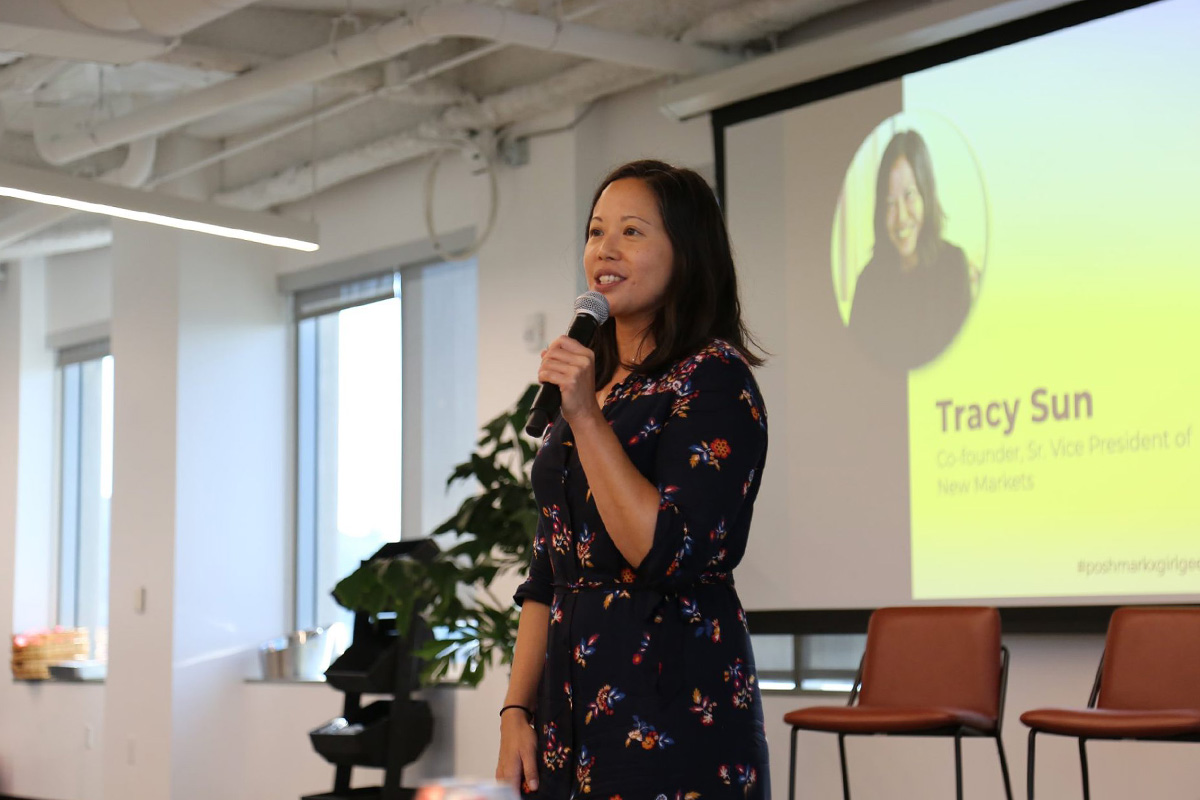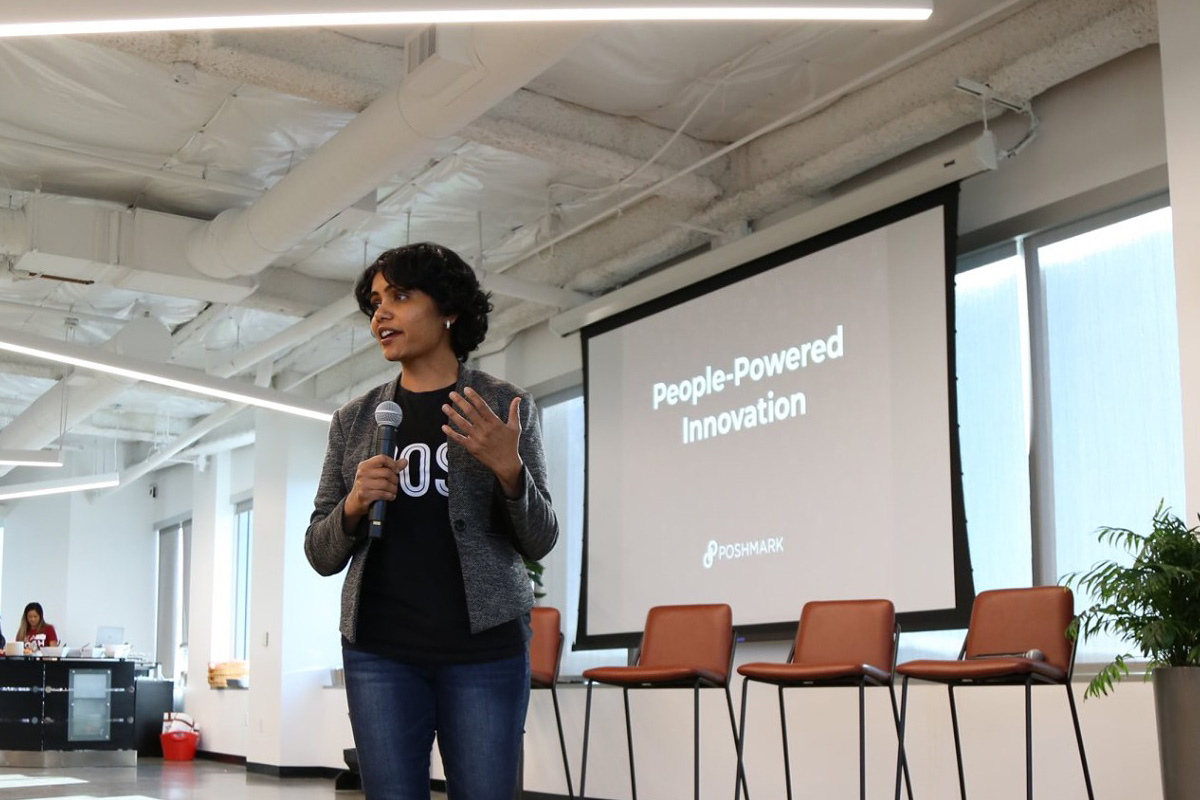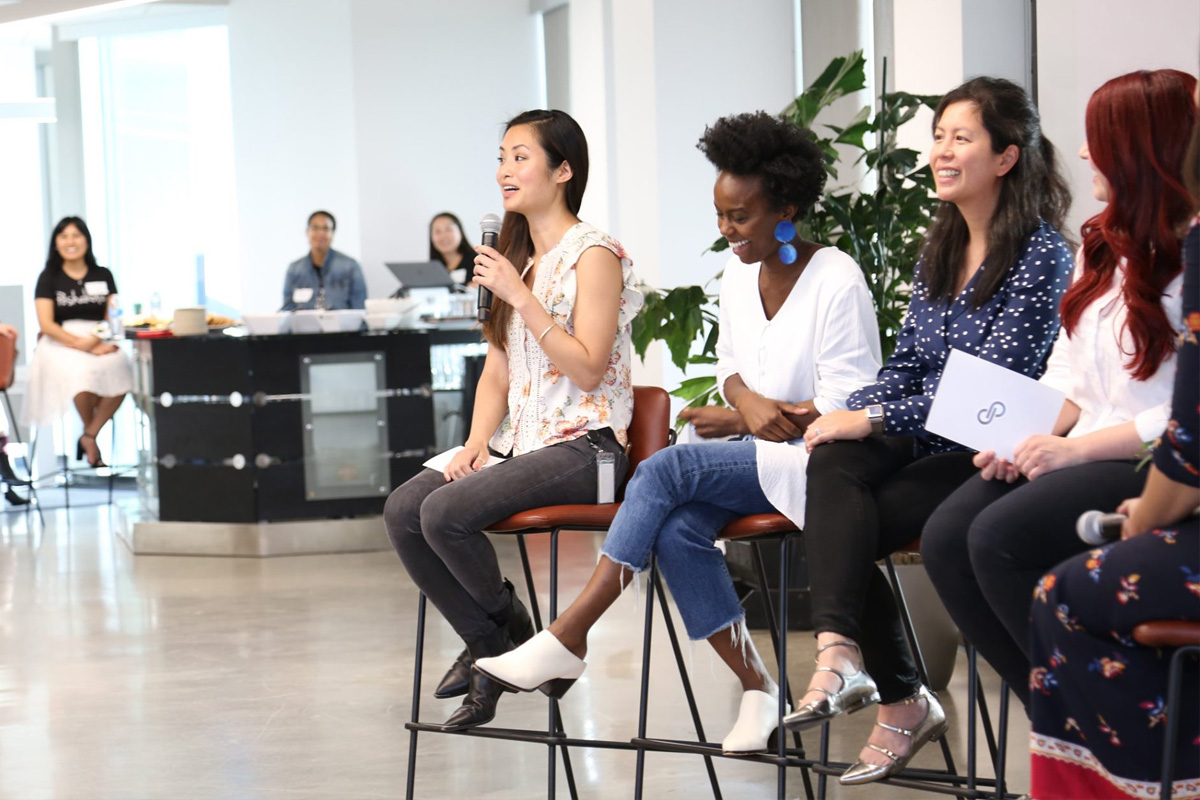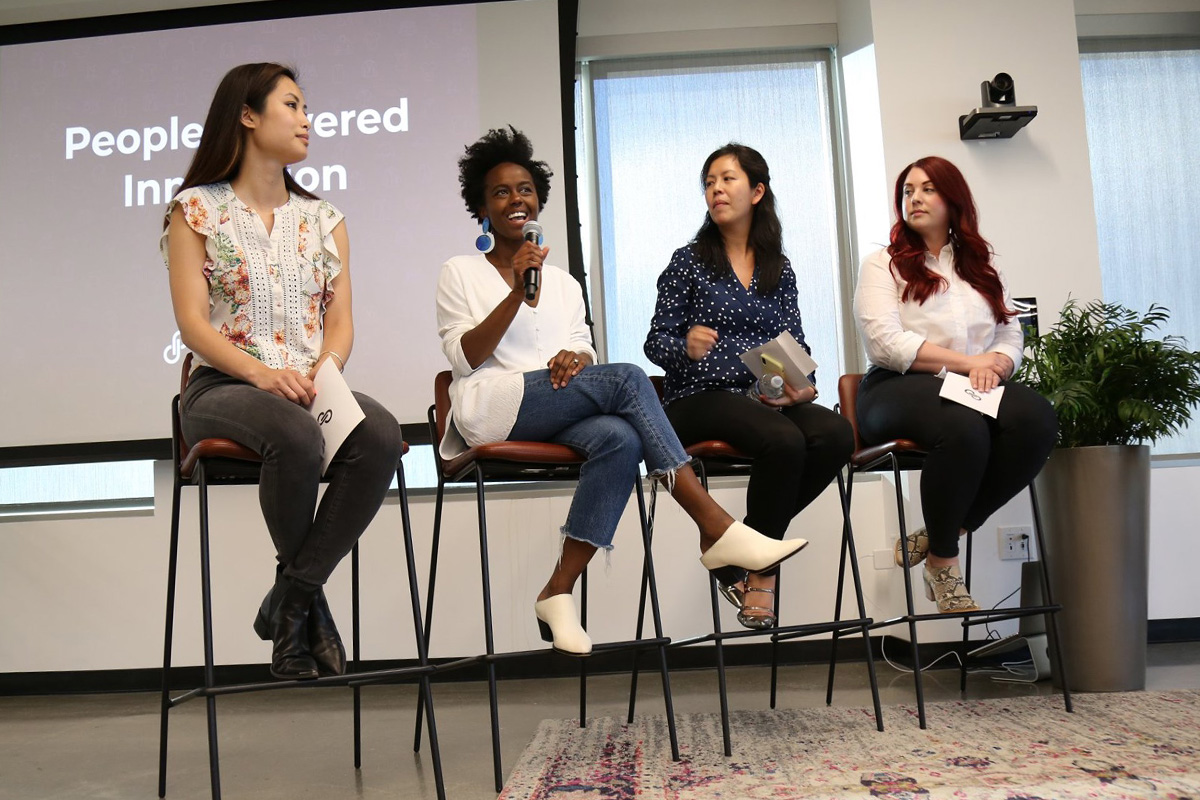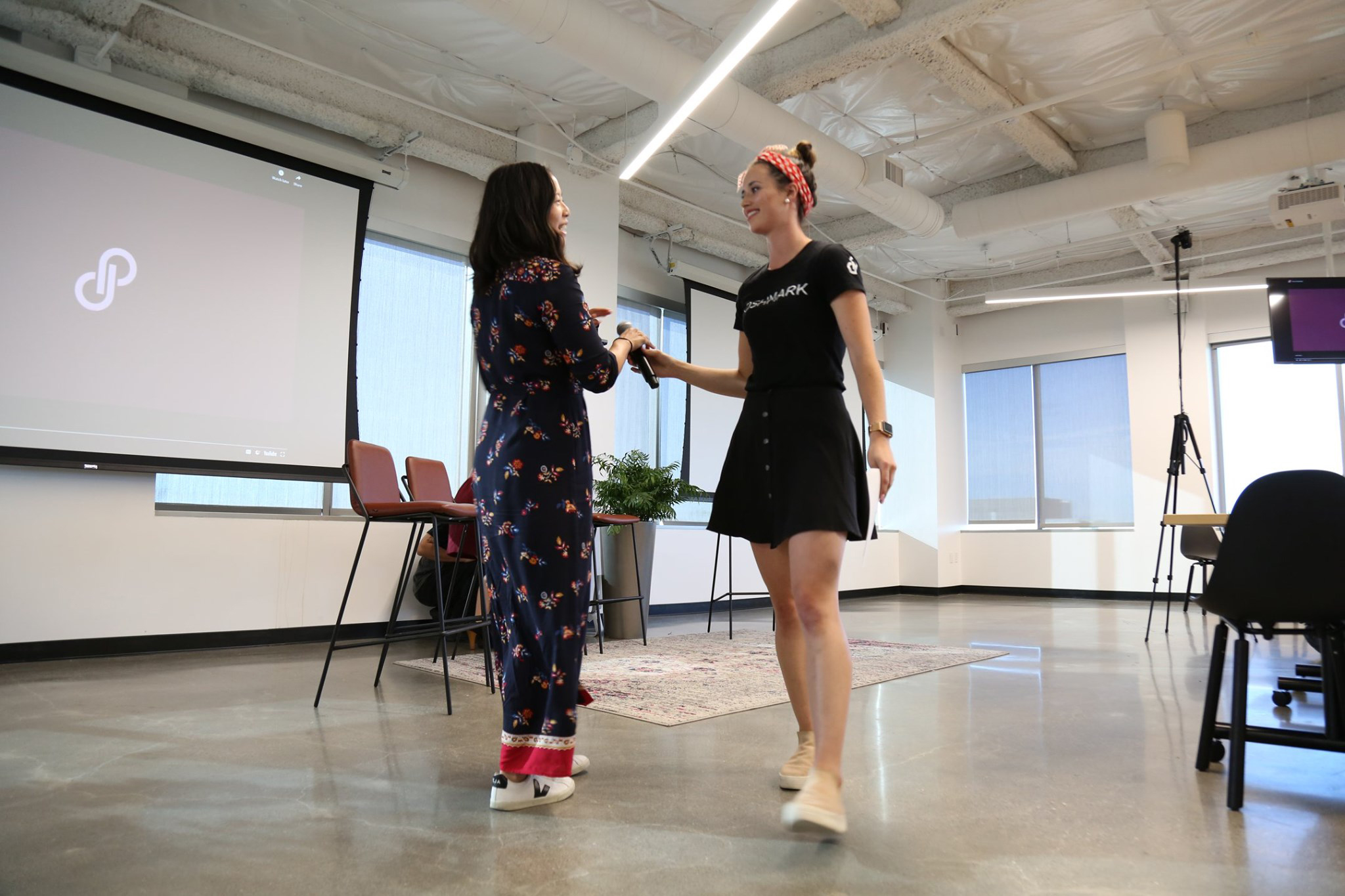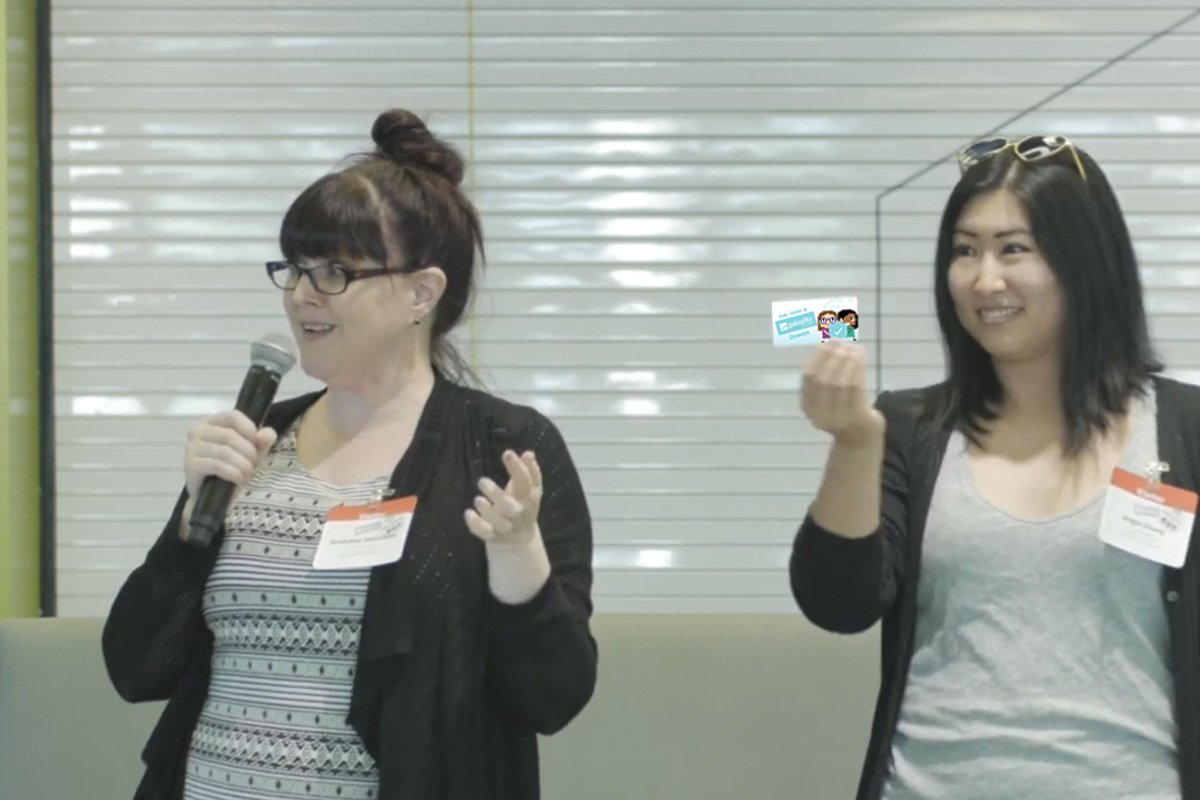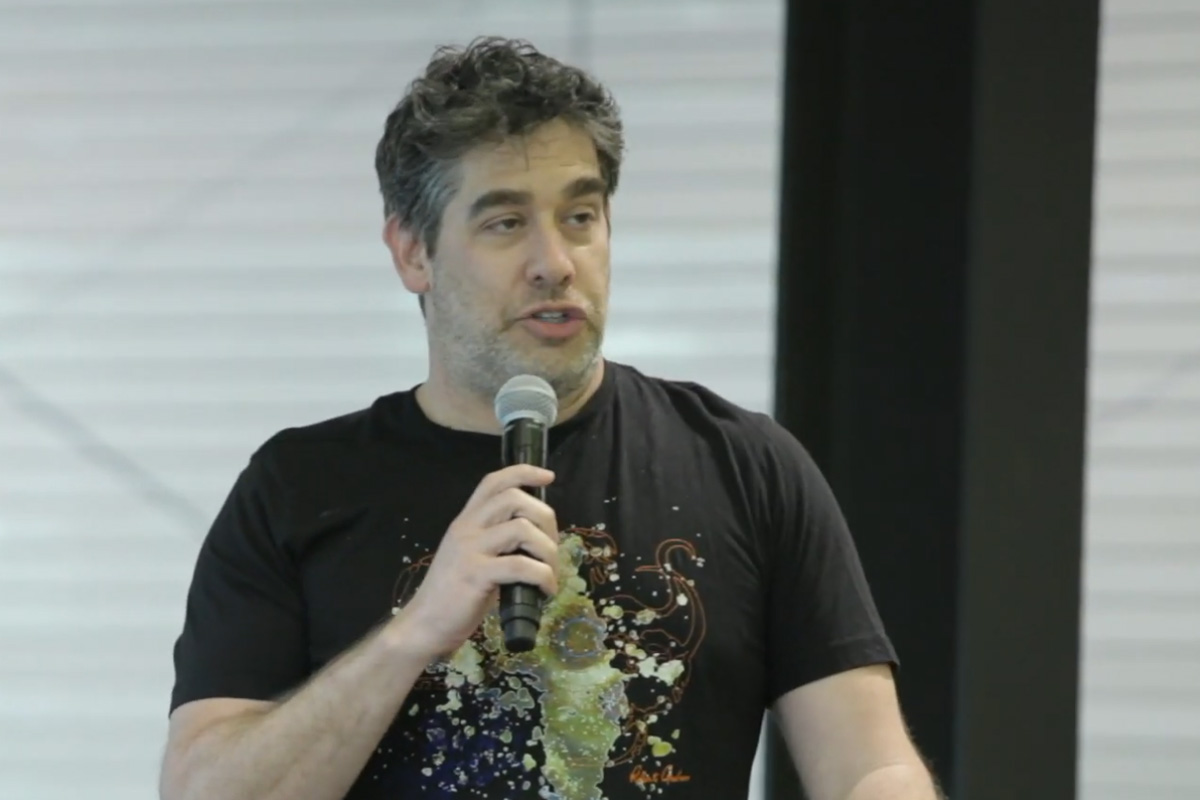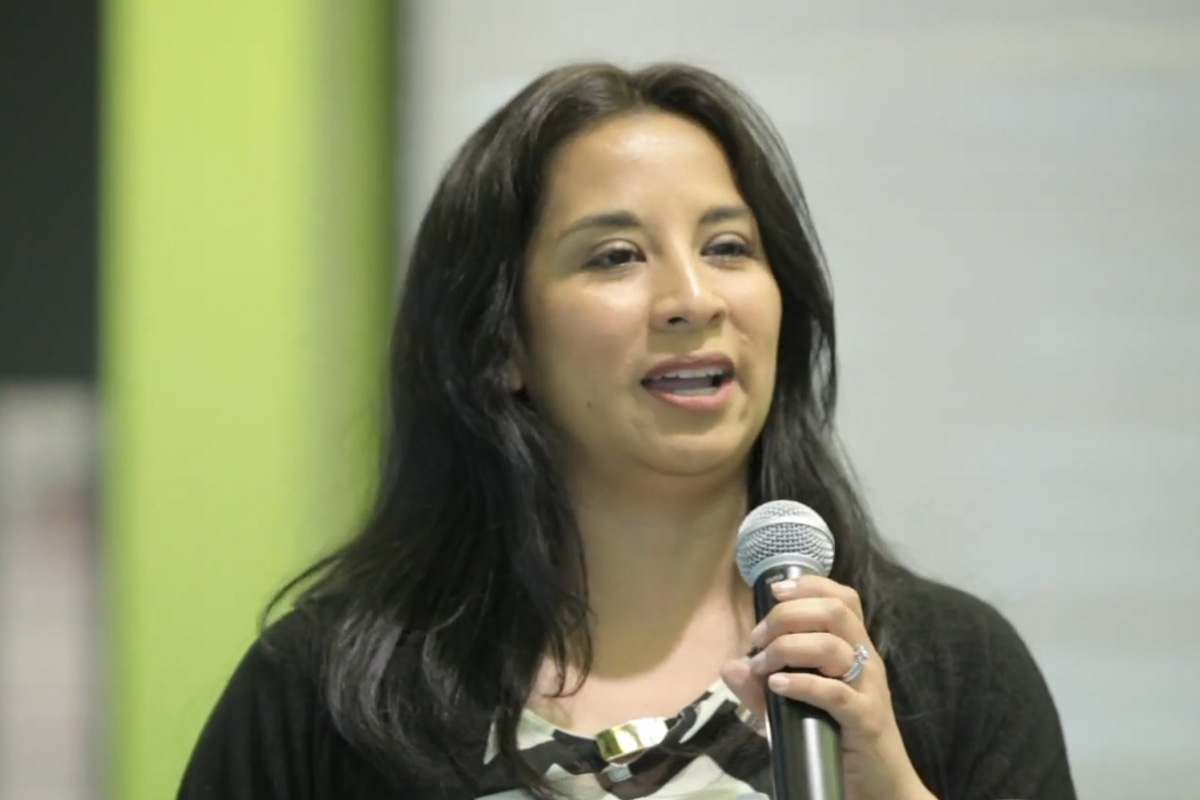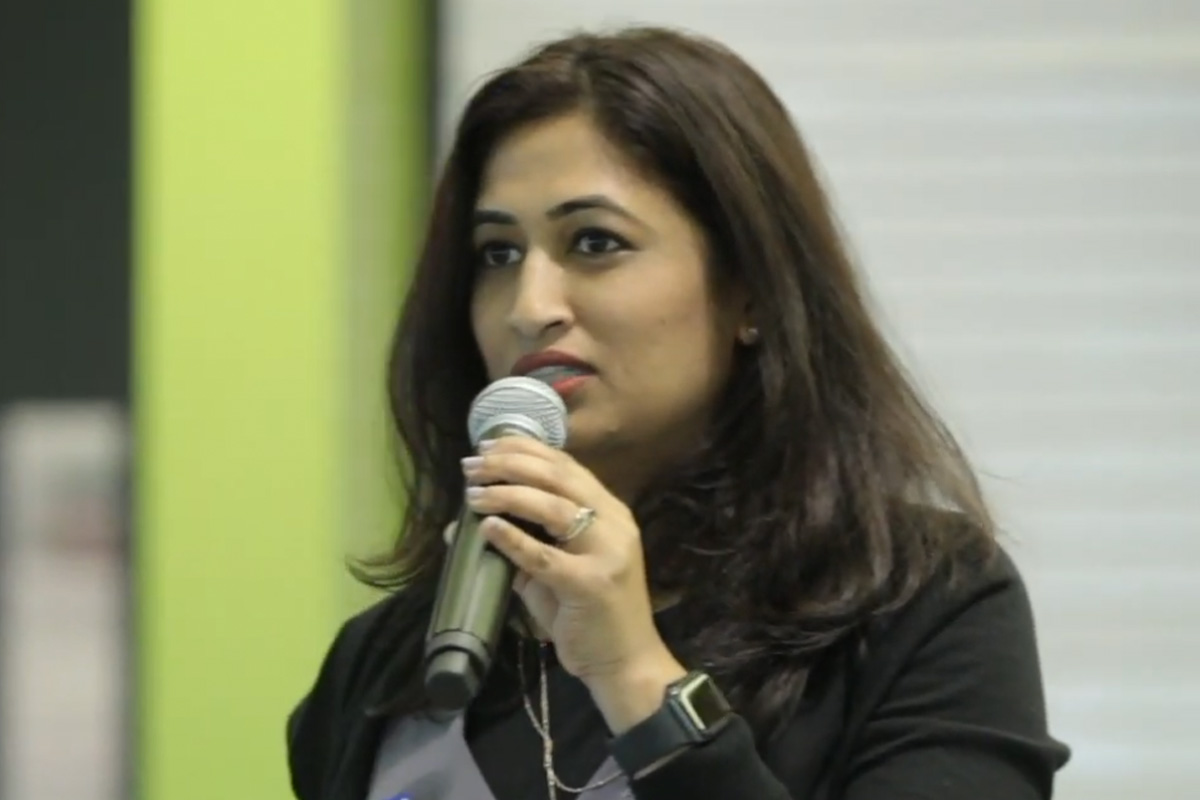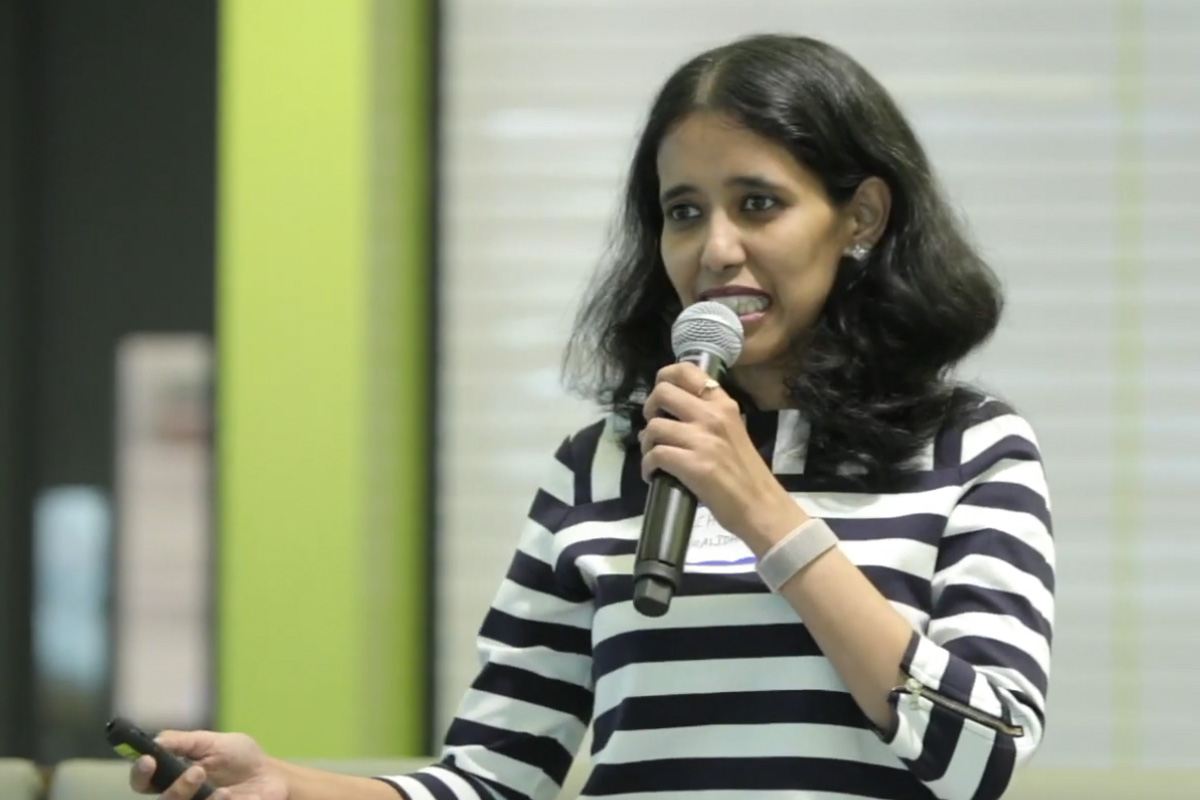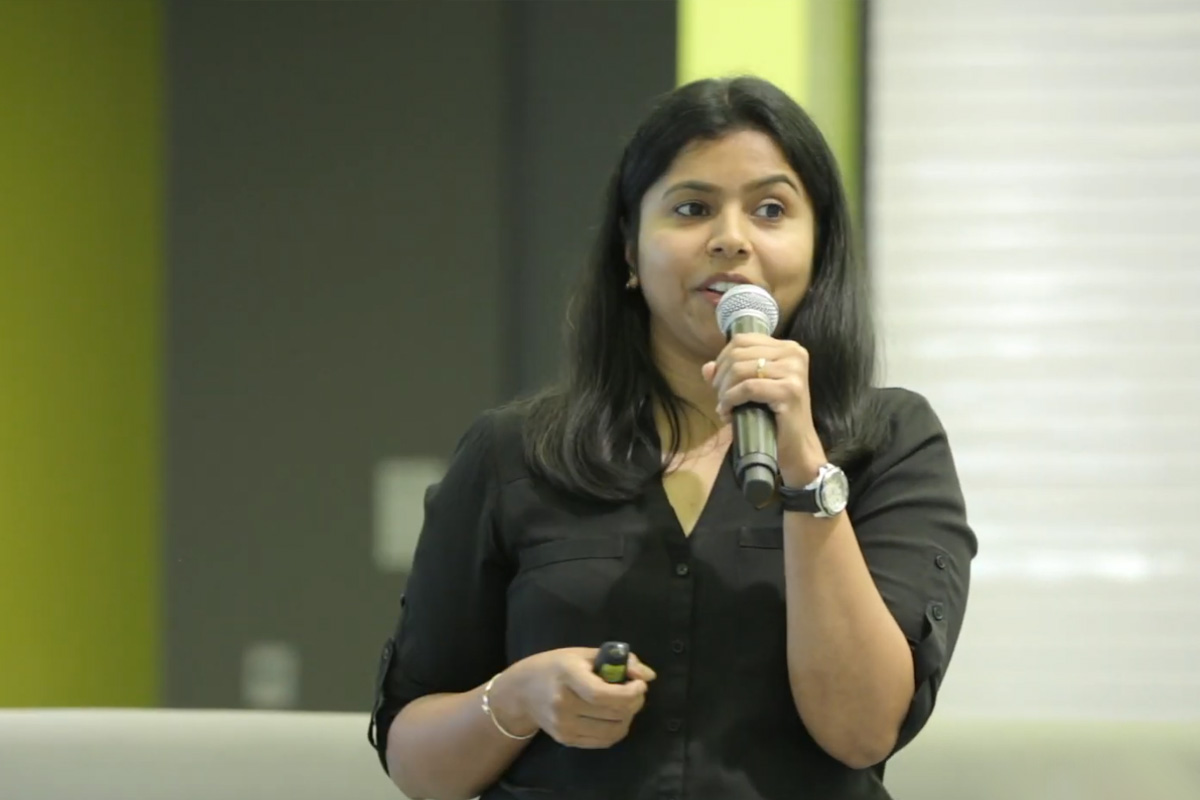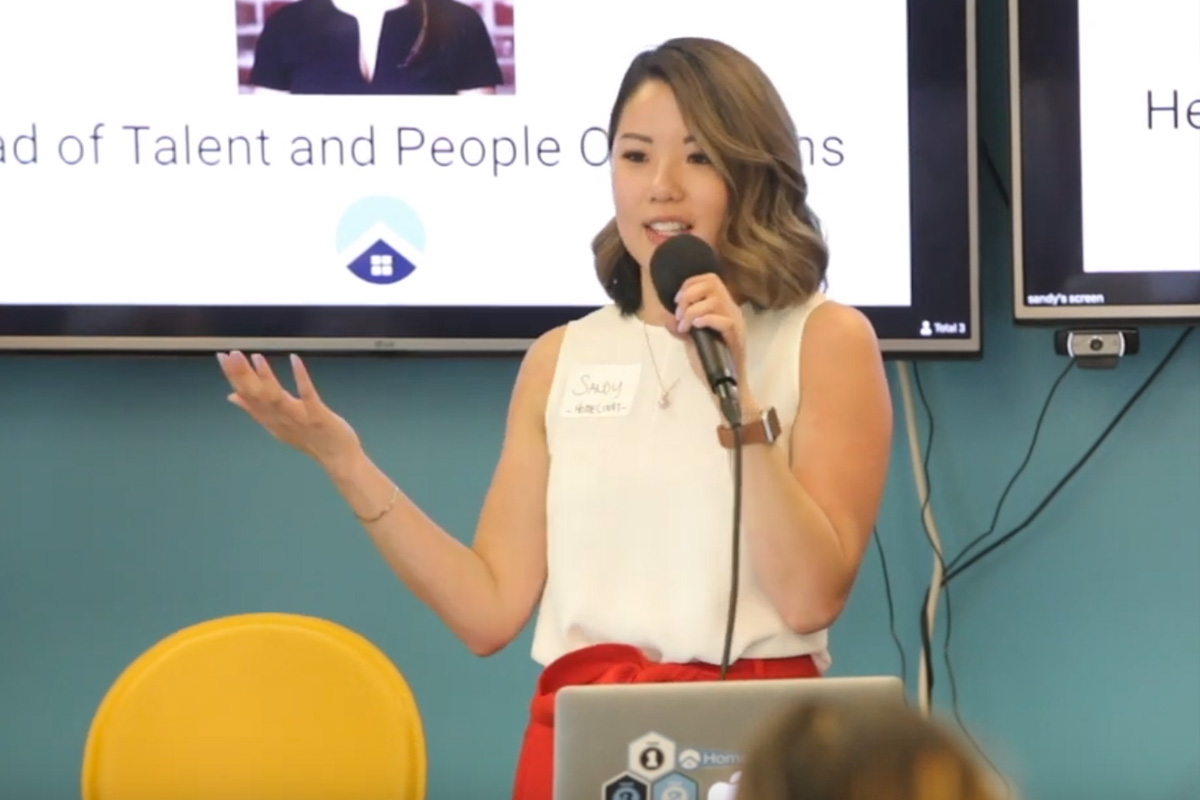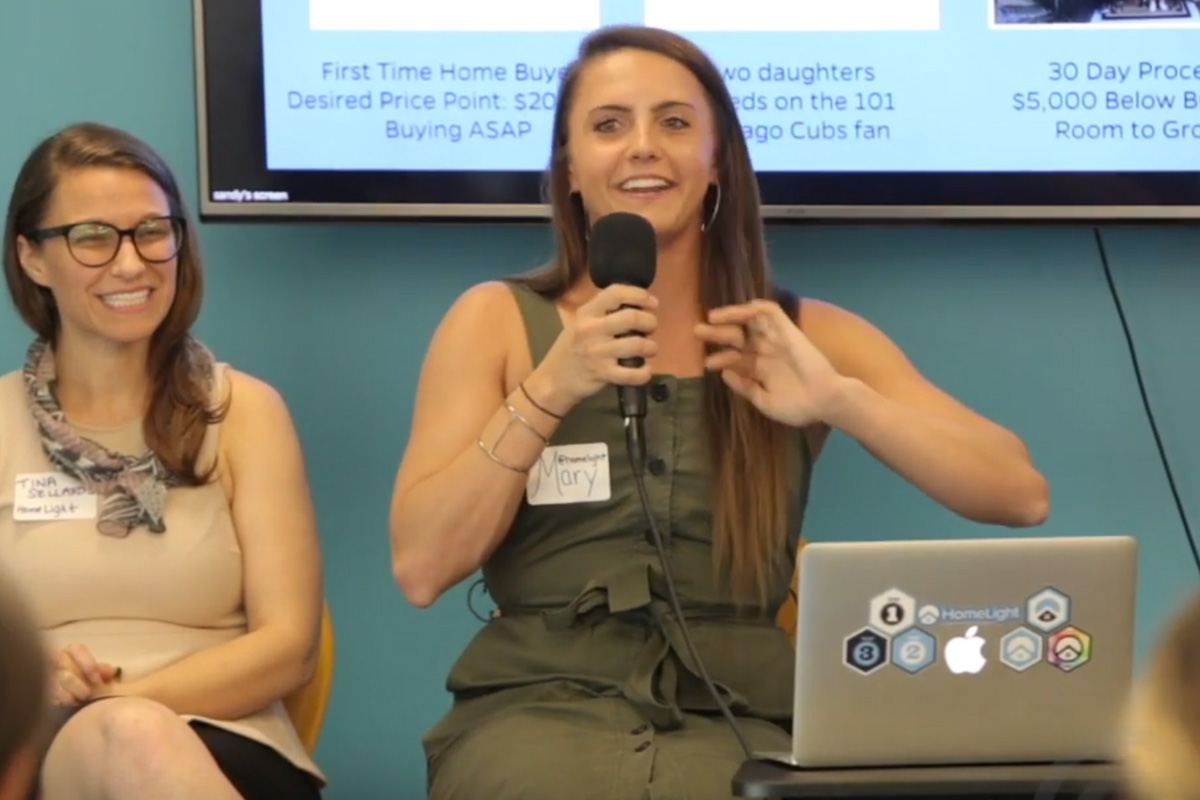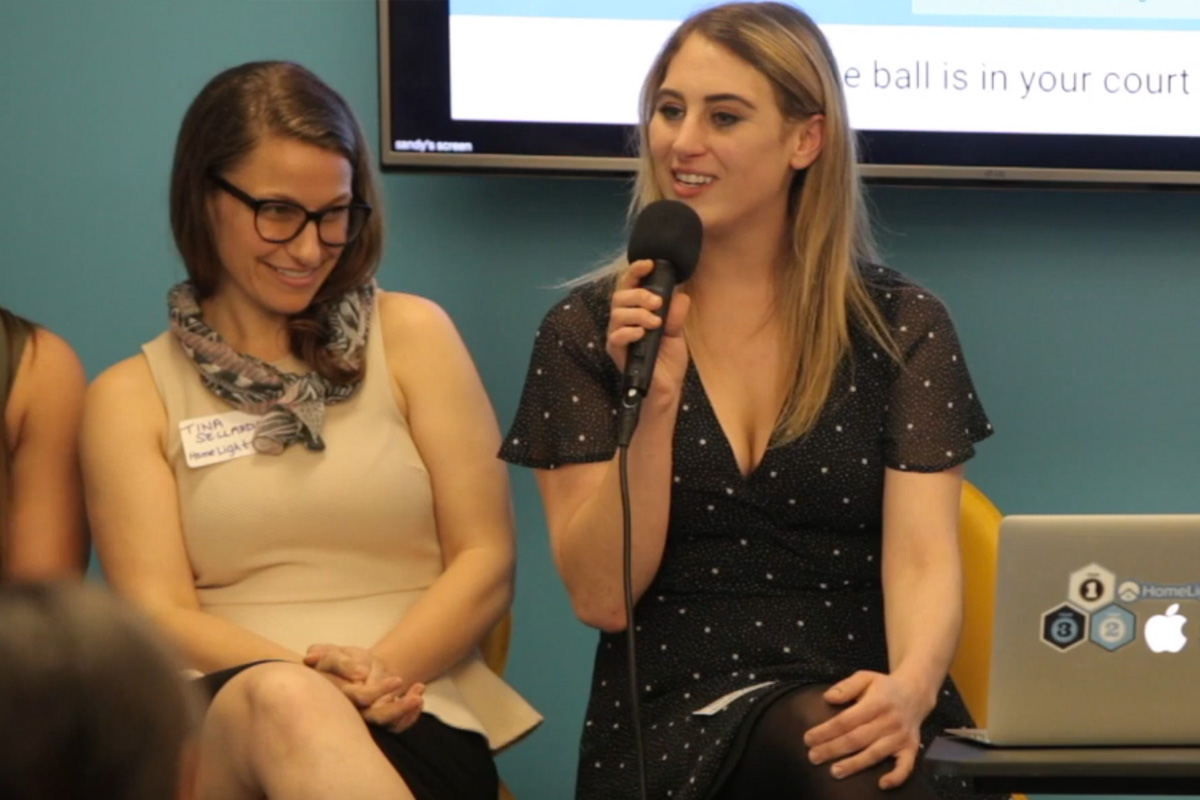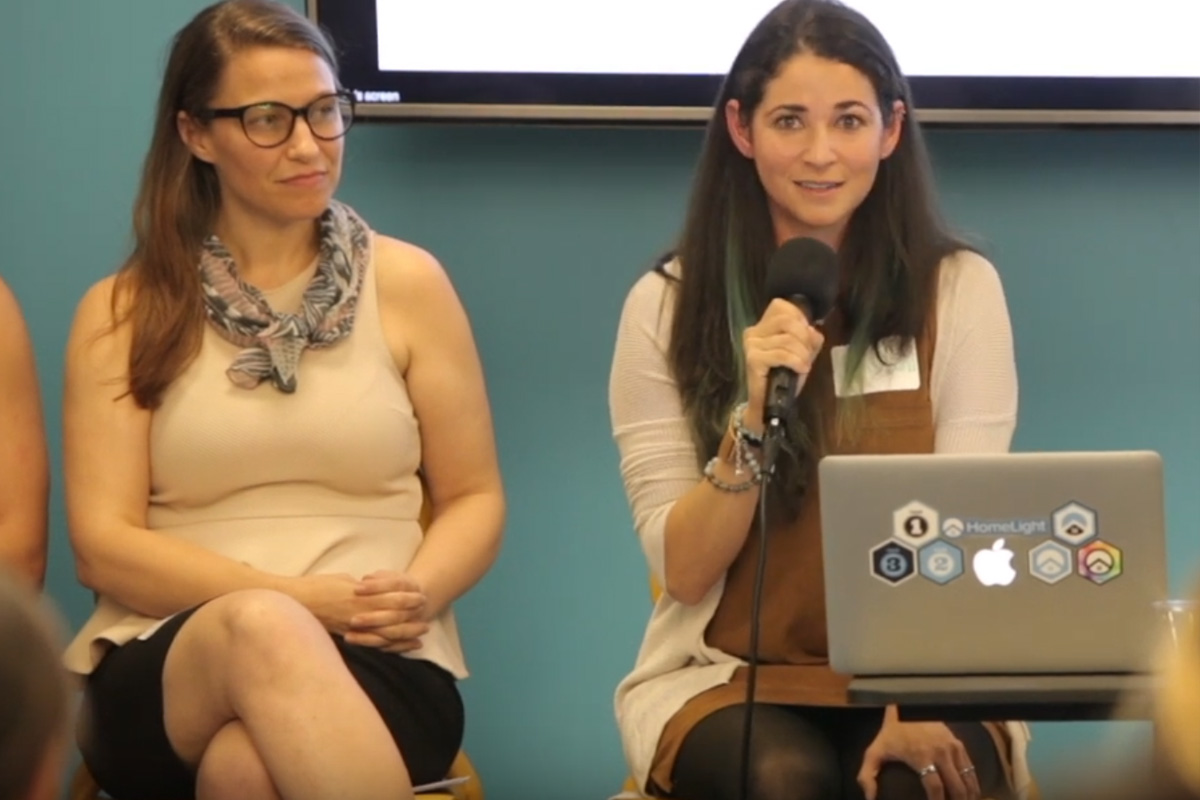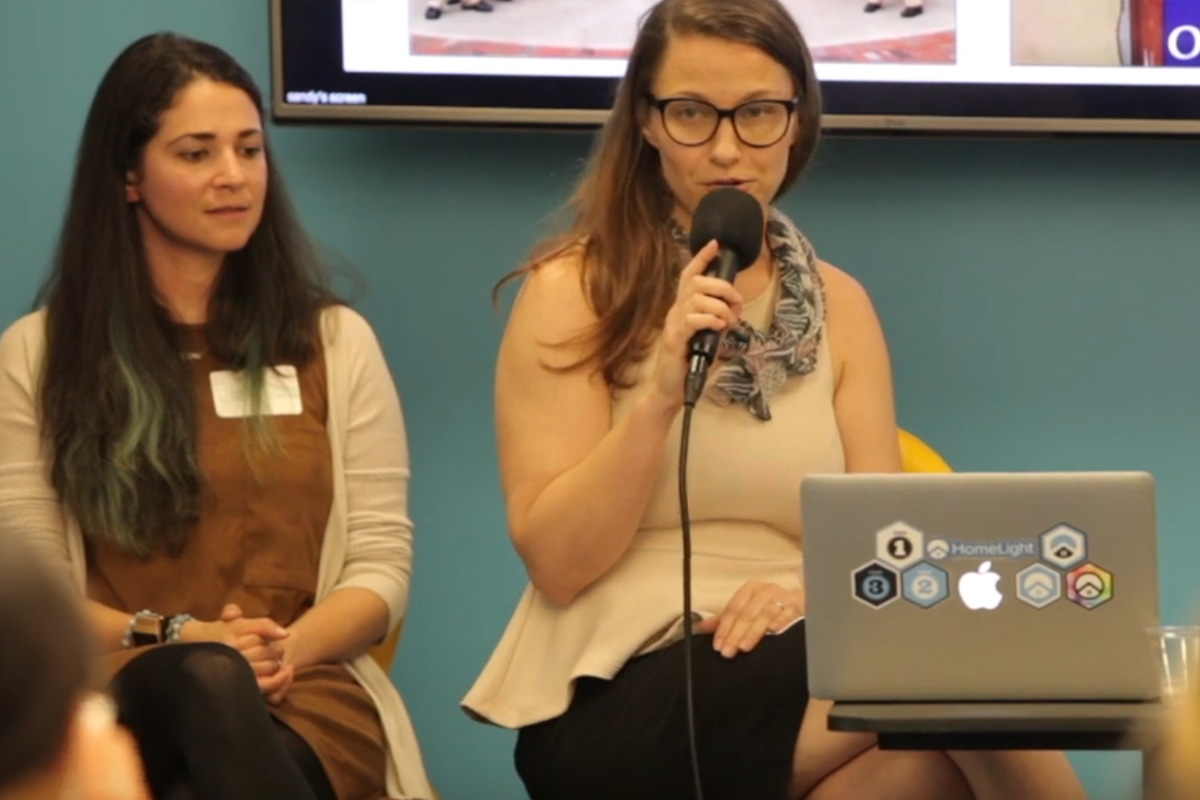Like what you see here? Our mission-aligned Girl Geek X partners are hiring!
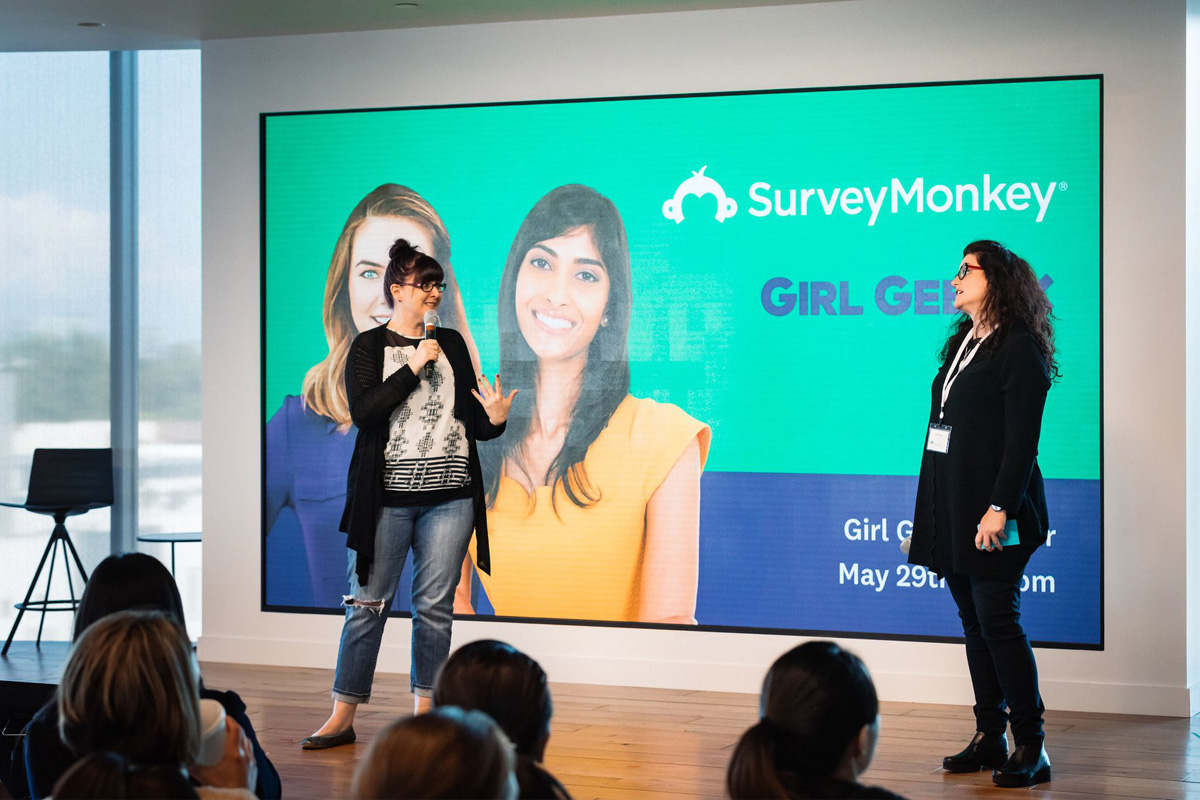
COO Gretchen DeKnikker of Girl Geek X introduces CTO Robin Ducot at SurveyMonkey Girl Geek Dinner in San Mateo, California.
Speakers:
Robin Ducot / CTO / SurveyMonkey
Sarah Cho / Director of Research / SurveyMonkey
Sarah Goldschmidt / Product Design Manager / SurveyMonkey
Mala Neti / Software Engineer / SurveyMonkey
Shilpa Apte / Engineering Manager / SurveyMonkey
Jing Huang / Director of Engineering, Machine Learning / SurveyMonkey
Erica Weiss Tjader / VP, Product Design / SurveyMonkey
Gretchen DeKnikker / COO / Girl Geek X
Transcript of SurveyMonkey Girl Geek Dinner – Lightning Talks & Panel:
Gretchen DeKnikker: Hi everyone. I’m Gretchen. I’m with Girl Geek X. Thank you so much for coming tonight. Welcome to SurveyMonkey. How awesome is this space?
Gretchen DeKnikker: It’s so good. I love it. I love it. Also, I’m going to introduce a unicorn in one second after I do my little spiel.
Robin Ducot: Spiel?
Gretchen DeKnikker: Spiel.
Robin Ducot: Spiel.
Gretchen DeKnikker: How many first Girl Geek dinner?
Gretchen DeKnikker: A lot. Welcome. We do these every week. We’ve been doing them for ten years. We’ve done like 250 of them so far. We also record them. They’re on YouTube. We do a podcast. It’s in the podcast places, so definitely check those out. Something we were talking about a little earlier, I was thinking the reason that we do these is to give women the opportunity to get up on stage and talk about being awesome rather than talking about being women. One thing I’ll challenge you guys with is find yourself a woke male and bring him next time, because there’s nothing gendered about this content, and building ally-ship is a really good thing.
Gretchen DeKnikker: Without further ado, I know I’m going to get comments on this, but I can’t wait to hear what the feedback is. Send it my way. I’m ready.
Gretchen DeKnikker: Now–
Robin Ducot: Hello.
Gretchen DeKnikker: Hi. I don’t know if you’re ever met a female CTO live and in person, but you’re about to. She’s amazing. In the like three minutes, we’ve just decided we were separated at birth and are going to be best friends now. Right?
Robin Ducot: We’re going to get caught saying something inappropriate at least once. We know this.
Gretchen DeKnikker: Yeah. We were really happy our mics were muted is basically what happened. Without further ado, please welcome the CTO of SurveyMonkey, Robin.
Robin Ducot: Hi. Nice to see everybody here. I’m so glad y’all could come. I’m Robin Ducot. I’m the CTO of SurveyMonkey, and we’ve got a great set of talks tonight. I guess we’re just, without further ado, we’re going to get started. Please, at the end we’re going to be taking questions right after the panel. We hope that you guys will have some interesting questions for us because we are excited to talk to you then and afterwards.
Robin Ducot: Why don’t we get started? Yeah? You ready? Why don’t I bring on stage Sarah. She is from our survey research team, and she is going to talk about surveys.

Director of Research Sarah Cho gives a talk on “Surveys: Why Do They Matter?” at SurveyMonkey Girl Geek Dinner.
Sarah Cho: Hello. Thanks. Hi. I’m Sarah Cho. I’m Director of Research here at SurveyMonkey. You’re probably wondering what a director of research at SurveyMonkey actually does, but what we do is we consult with all the different areas of the business from product to engineering to marketing to sales to give them advice on what is actually good survey best practices. You can think of our team as basically being the biggest survey nerds, or I guess for this crowd I should call them survey geeks, at this company. Of course, we can’t invite you to SurveyMonkey and not talk about surveys, so that’s what I’m going to be talking to you about today is first, let’s level set a little bit about what I mean about at survey. There’s a lot of different things that the word survey can mean. While this photo looks amazing and awesome, like I bet a lot of us would like to be up high on this mountain top, and we’re not talking about land surveying here. We’re really talking about survey in questionnaire form.
Sarah Cho: What I like to kind of describe surveys as is you’re having a conversation with a very specific purpose at massive scale. First, I’m going to walk through a couple of different ways that you can do surveys, talk about the different types of surveys that you can conduct, and then hopefully you’ve been inspired that you can go home and do some surveys on your own. I’m going to give you a couple of tips on how to make sure that your surveys are going to yield the highest quality data because it’s a little bit of art and it’s a little bit of science.
Sarah Cho: Surveys. They come in many, many different shapes and sizes. Has everyone taken a survey before? Yes. It could be on the phone. These are like the surveys that call you when you’re sitting down at dinner and you’re right about to take your first bite of food and they’re like, “Hey, will you take a survey?” It could come in person. Maybe it’s someone who’s knocking on your door or maybe you’re at the doctor’s office and they’re asking you a little bit about your medical history or increasingly, obviously what we deal with is surveys that are online. The great thing about online surveys is that they can be provided in a variety of different avenues. One of the more interesting things is surveying kind of where people are working, so utilizing Slack if you guys utilize Slack, and surveying people in Slack or maybe surveying people in Facebook Messenger. Really going to where the people are rather than trying to bother them in the middle of dinner or maybe in their face knocking on their door.
Sarah Cho: The beauty of surveys is that they can really be on any kind of topic. The most famous survey is probably the US Census, or the decennial census. Actually next year in 2020 is going to be the next census, so for everyone regardless of whether you are a citizen or not, that is kind of one of those myths they tell you about the census. Everyone needs to respond. If you don’t respond, technically you could go to jail, although I wouldn’t worry too much about it because they actually haven’t prosecuted anyone since 1970. It’s very highly unlikely, but the census is a really important survey. Things like congressional seats, which eventually turn into who is going to be in the White House, which we’ll leave politics out of it, but anyways, obviously very important decisions are made from the census.
Sarah Cho: The census is a really big government–Surveys aren’t necessarily meant for just only for big government or big business. You really can use them in many, many different contexts. If you know me in my social life, I tend to spam you with surveys a lot, all for various things like organizing camping trips. For this screenshot, which is a little bit blurry, I’m trying to organize friend’s birthday dinner at Beretta in San Francisco if any of you guys have been and just trying to figure out what to offer on the prix fixe menu. Very practical. Very helpful.
Sarah Cho: Another good way that people have utilized surveys in sort of a personal context that I haven’t really shown you here in this deck, but one of my co-workers have actually utilized surveys to ask people about tell me three words about myself on what you think about me. There was a lot of words that came up, things like thoughtful, really considerate, but what was actually more revealing in terms of thinking about her own professional development and growth is the words that weren’t represented. You can also utilize surveys for your own professional growth and development.
Sarah Cho: I talked a little bit about the government context, but another interesting government context is actually how you can utilize surveys to form opinions, sorry, to gauge opinions and make changes, whether it be in the government context with this where they were asking people who were serving in the military about what they thought about serving with a gay or lesbian service member. What they overwhelmingly said was that actually we think that regardless of someone’s sexual orientation, they can effectively do their job. That eventually was evidence that congress used to repeal Don’t Ask Don’t Tell. You see this in the workplace a lot. A lot of organizations are asking employees about what they feel about their workplace. Employers are actually taking that information and making meaningful changes.
Sarah Cho: We do that, for example, at SurveyMonkey. Obviously we like to eat our own dog food or drink our own champagne, whatever the better phrase is for you guys. For example, we did a survey about do people feel like they are included within our SurveyMonkey community? Do they feel like they belong? Actually, because of that, we found that a lot of people didn’t feel like there was a good path to growth within the company, so we made a lot of different changes like having a career ladder, changing from a yearly review cycle to a quarterly what we call growth impact and goals cycle. We’re able to make a lot of these changes and a lot of organizations are doing similar things.
Sarah Cho: Then finally, a lot of people use them for market research. I like to use this example because it’s a silly example. Maybe they should have used some market research here. This is a product called a UroClub. In case you’re ever on the golf course–I don’t golf myself so maybe it’s a bad example, but in case you’re ever on the golf course and you need to go to a restroom and there is none available, you can utilize this golf club to relieve yourself. Clearly they didn’t use any market research for that, so obviously it’s good to use surveys to make sure that you are doing well in that area.
Sarah Cho: Now going onto a few tips about how to create better surveys for you. The first thing is questionnaire design. You can see here, if I were to read this entire question, that would take up the rest of my 10 minute lightning talk, so I’m not going to, but you can see already visually without even reading any of the words, it’s a bad question. There’s a lot of words, TLDR. Remember when you’re writing survey questions, surveys are super visual. If you have a huge block of text, whether it be in the questions or a lot of answer options, people don’t like to read through that, not because they’re being lazy, but you really should be designing with your respondents in mind.
Sarah Cho: The next thing that I like to point out is jargon or industry terms. A lot of times we are so specialized in our industry, so in the survey industry there is this thing called acquiescence bias. Has anyone heard of it? No.
Sarah Cho: If I asked you guys about acquiescence bias, one person maybe, yeah. Most people would be like, huh, what. That’s the whole point. You shouldn’t use terms that only people in your industry are aware of, or the worst is acronyms. Here it’s how would you rate our POS system? Has anyone worked in retail or restaurants? You probably know what a POS system stands for. It stands for point of sale. If you don’t work in restaurant or retail, POS might mean something very different, like are they asking me about the toilet? Instead, you should be very clear. You really want to know how was the checkout process? Instead of using any acronyms or jargon, really stick to something that’s really clear that can be understood by everyone. A good rule of thumb is things are at an eighth grade reading level. That’s generally a good rule of thumb for surveys.
Sarah Cho: You can spend a lot of time on your questions and a lot of time looking at your answers, but then, sorry, you already got the joke. Sometimes you also need to pay attention to your response options, not just the questions themselves. This is a good example. It’s probably someone who maybe was asking about ethnicity and accidentally included Chinese in sexual orientation, but clearly that’s not right. This is also a key for you guys just to remember if you are doing surveys, always have someone else preview your survey for you because it’s like writing a term paper when you’re in college. You don’t realize there’s a typo in the first sentence of your paper that’s like 20 pages long and you’ve read it 15 times. A lot of the times, if someone else takes a look at your survey, they’ll be able to point out things like this that you may have missed.
Sarah Cho: You could write the perfect survey with the perfect response options and then kind of bungle the data analysis. In this particular example, does anyone know what might be wrong here?
Sarah Cho: Yes. It adds up to more than 100. It adds up to 120 and the last time I checked, a closed ended question like this typically adds up to 100. Just make sure that you’re double checking what we like to call number checking or fact checking. That is a crucial step. Another, again, I’m sorry I’m picking on Fox News, but their graphics department is pretty horrible. You can see here that they’re showing a difference between, it looks like a really big difference, right, like between now and January 2013. It looks really big, right, but actually it’s only 4.6 percentage points. It’s 35 to 39.6. That is actually where someone is playing with the axis and making a difference much more magnified than it actually is. This is a good example of not only things you should avoid, but other things you can kind of see when you’re interpreting other people’s data to see if they’ve kind of messed around with the interpretation of it.
Sarah Cho: Just to wrap up because I only have around a minute left, or actually I’m over a minute, sorry. I don’t know how to use this timer. Here are a couple use cases that you can think about. We’ve talked a little bit about them, but remember you can always survey your customers. Even if you don’t have customers, say you’re a teacher, you have students. Survey your students. You can always gain product feedback. Say you are thinking of starting your own company, but you’re probably going to get very biased opinions if you ask your friends and family member. They’re either going to say that’s a really awesome idea, because they don’t want to offend you, or they’re going to say maybe you should stay away from that because they think you shouldn’t take that risk. Always ask for feedback from people you don’t know.
Sarah Cho: We talked a little bit about employee engagement, but there’s a lot of different ways to make sure your team is happy. We talked about inclusion, but there’s always from the minute they step in your door as a candidate to the minute they leave as someone who is no longer an employee of your campus. You can always, we like to say we want to empower the curious, so satisfy curiosities whether it’s thinking about what markets you can potentially expand to or maybe if you want to go back into academia or just put your academic hat on and just think a little esoterically about one specific problem, you can always think about what is the survey component to that.
Sarah Cho: Finally, I talked a little bit about the example about utilizing it for personal and professional growth, but just to wrap up, this is just saying that even if you don’t want to create your own survey, you can still help us survey nerds out there by being a respondent. Make sure if someone sends you a survey request, just take a few minutes out of your time, respond to that survey because that’s really going to help the people out who are sending it out. I’ll be here around in the networking hour and for Q&A. Thanks for listening.
Sarah Cho: I’m also going to now turn it over to Sarah on our product design team. We’ll keep it easy with the same names.
Sarah Goldschmidt: We good? Hello? Hi everyone. Good evening. Thanks for coming. I have a slide, I promise.
Sarah Goldschmidt: It’s not? I’m holding the clicker. Duh. Anyway, user experience. Thanks all.
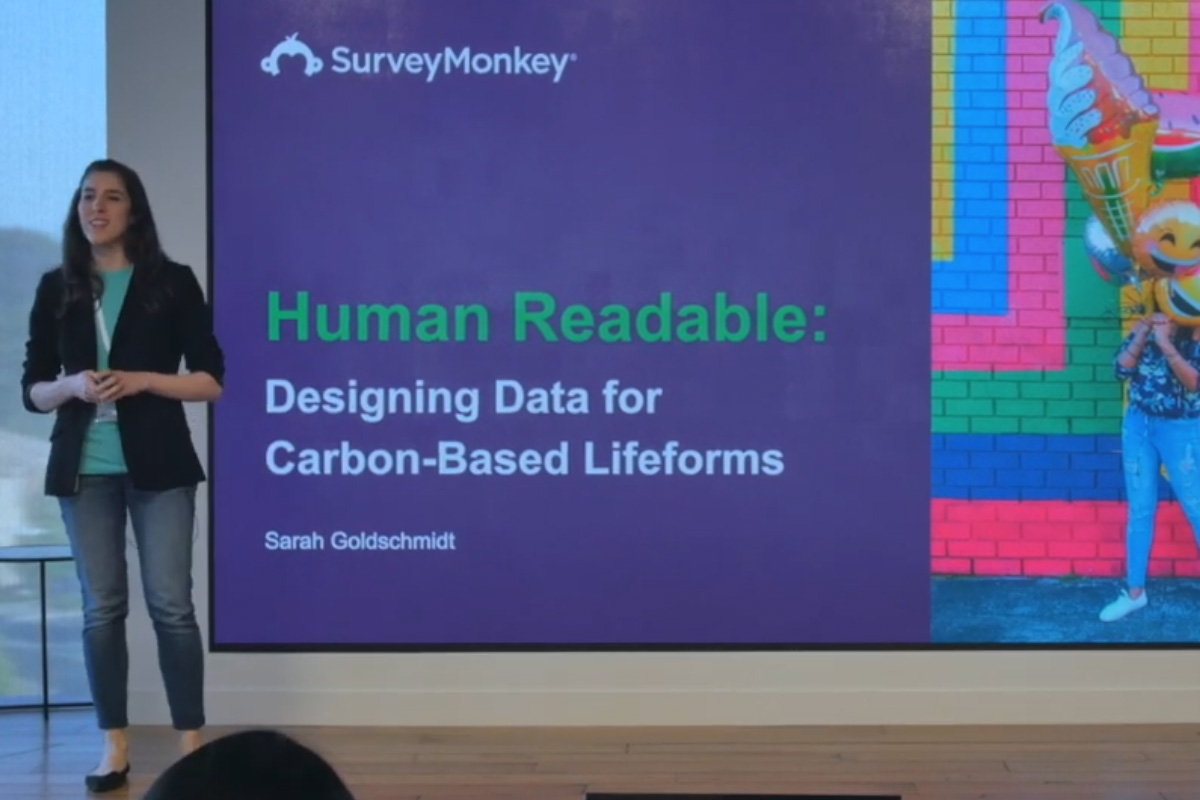
Product Design Manager Sarah Goldschmidt gives a talk on “Human Readable: Designing Data for Carbon-Based Lifeforms” at SurveyMonkey Girl Geek Dinner.
Sarah Goldschmidt: I’m a product design manager here at SurveyMonkey, and I’m here today to talk about designing data for carbon-based lifeforms. What does that mean? I know, it’s funny. You’re laughing. It’s designed to laugh. That’s great. We’re going to talk about designing for carbon-based lifeforms, which is us, people.
Sarah Goldschmidt: I want you to take a moment and just think about in 2019 the way we think about data has really evolved from the output of a product to kind of the product itself. I want you to hold that in your mind for the next ten minutes because it’s really the crux of the conversation that we’re going to have today. We as makers of products, whether we’re designers or engineers or product managers or marketers, all play a role in defining the relationship between the product that we make and the data that it collects, creates and disseminates into the world. What I’d like you to walk away with is kind of a call to be more curious and more creative and more expansive in your thinking about how we define this relationship.
Sarah Goldschmidt: This is a chart. Everybody has probably seen a chart like this at some time in their life. You’ve probably made one. You maybe made one in elementary school. Charts and data visualizations are a powerful way to make data, particularly numeric data, visible to the human eye. They can also be a crutch. We can over index on them. I say this as a designer who has probably been guilty of this. We receive data that we’re told is important for a product. Users must use this somehow. We spend a lot of time designing the container for that data. We visualize it. We make really beautiful lines and then we kind of leave it there. We don’t ask more questions. We don’t curate the palate of data that we might be working with.
Sarah Goldschmidt: Charts are great for making data visible, but not human readable. That requires meaning. What’s this idea of human readability? I will confess, I made it up. I will define it for you. Data becomes human readable when through the power of design we wrap that data in meaning. Meaning is how we get from 1, 2, 3, to aha. That aha being how people understand how to feel about the data, how they react to the data, and how they can act with it.
Sarah Goldschmidt: I want to talk a little bit about two products here that are really wonderful examples of thinking more expansively about data as a product and about making that human readable. One of my favorite examples is Spotify. Spotify is not typically what you think of when you think of a data company, but Spotify is sitting on mountains of data, millions of users and all the data associated with how they listen to music. They don’t surface this in the app. You probably don’t want to know how many times you’ve replayed the Justin Timberlake song over and over and over. It probably wouldn’t be good for their business model, but somebody at Spotify decided to sift through that data and thought maybe it could become a product itself. Thus, the Wrapped report was born.
Sarah Goldschmidt: I don’t know how many people here get a Wrapped report. I get a Wrapped report. You get a Wrapped report? Awesome. For those of you who haven’t gotten one or don’t know about it, what happens is at the end of the year, in this case, 2018, Spotify is going to send you out this beautifully designed, curated mini-site that essentially tells you the story of your year through the way you interacted with music. There’s really lovely insights. Sometimes it’s funny. Sometimes it’s cringe worthy, but it’s really designed to share. Of course, this exploded into a phenomenon. We’re posting it all over buildings. We’re talking about it on the news, and of course, we’re sharing it with our friends. One of the remarkable things about this is that it wasn’t successful because the data was solving a really huge problem or being used in some kind of scientific theory. It was making people laugh. It was making people reflect, and it was helping them connect with each other. That’s human readable data turned into a product.
Sarah Goldschmidt: This is one of my favorite examples. They went further, right? They were farther and somebody sifted through all that data that Spotify has to come up with these advertisements that went a step further and told the story of the cultural year of 2018. Some of you might have had the great pleasure of seeing shark do-do-do-do-do, a viral kids video that’s actually quite annoying. This is just one example of this advertising campaign that they’ve rolled out. I encourage you to look it up. They are really funny, but again, taking what is actually just a pile of data somewhere in a database and telling a story with it, making it meaningful and having it touch people in various ways. Making them laugh.
Sarah Goldschmidt: Another example that might be more relevant to us in the room, those current product managers, designers, and engineers or aspiring ones, this is SurveyMonkey Engage. Engage is a stand alone product that we make here at SurveyMonkey. It’s designed to help employers connect with their employees to better understand what’s going on and improve their workplace culture. The data that Engage collects and disseminates is almost completely numerical, so we’re stuck in that position of saying we’re going to have a lot of charts because we have to display that data. We have to display the relationships between that data, allow people to filter it, et cetera, et cetera. What you also see in this interface are a lot of words. That was the secret to making this data more human readable.
Sarah Goldschmidt: Where we got to this is we decided people are changing human culture. What’s important to them? It’s probably not sitting around and looking at a bunch of numbers. Our users want to spend more time connecting with their employees and creating change, and numbers don’t create culture change. People do. Conversations do. Relationships do. We thought how do we apply that to numeric data? And the secret was in what we call the core factors of engagement. We did a bunch of research, looked at all the data points we were collecting, and we saw that they grouped into conceptual chunks. What that allowed us to do is instead of giving a bunch of data points related to how people interact in your workplace assigned to a number of questions in a table, we wrapped it in words. That’s team dynamics. Then we named a bunch of areas of engagement, purpose alignment, visible future. We created language. The focus for our users, instead of nitpicking at the data itself, which is available when you want it, you have shared language with your employees to be able to talk about what’s going on. The data, the numeric data displays that kind of supporting role to be able to talk about direction at a later date.
Sarah Goldschmidt: Something that these two really have in common, you’re probably hearing me say the word story. It’s not just meaning that we need to make data human readable, it’s story. When you string meaning together, you really get a story. That’s what a story is. Stories have been used for thousands of years for humans to be able to understand their world, their place in it, and how they can act. It provides that extra oomph. When design transforms data into story, that’s when the magic happens. The magic is that connection and action.
Sarah Goldschmidt: What I think is really important for the take away today is that anybody can make the magic happen. It’s all about starting a conversation and providing perspective. I’m going to give you four steps that anybody in this room can take to start the conversation in your organization or your school or your product company to get data from being kind of just a set of numbers in a table, maybe, to human readable data.
Sarah Goldschmidt: Step one, find what’s important to your people. I use the word people very specifically here, not users. Users are users when they happen to be using your product, but they’re always people. Ask yourself what’s important to them when they’re using the product. Sure, it might be in a business context, but what’s important to them as a human being? Maybe they’re particularly concerned about what their boss thinks of them. That’s nerves. Maybe they’re stressed out. Maybe they want to buy a really cool shirt and your data is going to help them do that. I don’t know, but that’s the questions. When you find out what’s important to your people, it tells you what kind of meaning you need to wrap your data in.
Sarah Goldschmidt: Step two, prepare your palette. Your data palette. As a painter, I want to be able to paint with as many colors as I possibly can to open up more and more types of stories that I can tell. Don’t cut yourself off early by assuming you know what kind of data you need to display and what you can do with it. Take it all, but remember to do it ethically and responsibly.
Sarah Goldschmidt: Step three. Design a story, not a chart. Those charts are going to come in and really help you tell a story visually, but think about the story first. What kind of meaning do you want to string together? What do you want somebody to be able to do, and then build your charts after that to help support the story.
Sarah Goldschmidt: Step three. Validate the aha. All I know for designing with data for many years is that every time I think I’ve really got it down and I’ve got a universal story that everyone is going to understand, it’s absolutely not true. Users find out a new thing to do with it. I get to learn from that, so always validate your aha and watch your story evolve. It’s a participatory sport.
Sarah Goldschmidt: With those four steps, you’ve really got what it takes to start working with human readable data like a champ. I’m going to encourage you today to be curious, have fun, and make something meaningful. Thanks so much for having me today and for listening. I will be around for questions if you want to talk about product design or data or this weird concept of human readable data. Thank you so much.
Sarah Goldschmidt: I’d like to call my colleague Mala up here to talk about engineering.

Software Engineer Mala Neti gives a talk on “Transforming SurveyMonkey’s Front-end Platform with GraphQL” at SurveyMonkey Girl Geek Dinner.
Mala Neti: Hi everyone. I am Mala. I’m a software engineer here at SurveyMonkey. Today I’m very excited to share with all of you our journey of transforming SurveyMonkey’s front end with GraphQL. Let’s start by talking about 2019. 2019 was a pretty fun year for us here at SurveyMonkey in part because we were able to completely reimagine our front end architecture. What did this mean for us?
Mala Neti: To start, we were able to work towards consolidating our numerous individually deployable and siloed micro webs into just a handful of apps built on React and Node.js. We were able to introduce a very slim aggregation layer with GraphQL that sits between our front end and our back end collection of rest APIs where all of our business logic and application logic are hosted.
Mala Neti: Today I wanted to focus on the aggregation layer portion using GraphQL, but before I do that, I would love to get a gauge from the audience. How many of you have heard of GraphQL?
Mala Neti: Nice. How many of you have worked with GraphQL in any capacity? Not bad. More than I was expecting.
Mala Neti: For those of you who haven’t, GraphQL is simply a query language for APIs. You can think of it as making it easier to build out your front end by providing a declarative way of fetching data without having to have knowledge of the entire system. In that way it kind of separates the back end–innovation of the back end, from the front end and kind of makes them completely independent. In addition, graph APIs are organized in terms of types and fields rather than endpoints, so the client can get as many resources as possible in one single request to one single endpoint or as I like to call it one endpoint to rule them all. I did not come up with this even though I think it’s pretty genius.
Mala Neti: I think it’s easy to see why GraphQL or the performance benefits that probably come from using GraphQL with this declarative and efficient type of data fetching. Spoiler alert, it worked. For the pages that we have today powered with GraphQL, we saw a huge reduction of payload and a huge reduction of data sent to the client, and a huge improvement in our time to first interaction. This is a really big win for us and for all of our users of SurveyMonkey product.
Mala Neti: Now that we know that it works, let’s talk a little bit about how it works. We have our GraphQL client and our GraphQL server. At the center of our GraphQL server is our schema. Our schema is basically just the contract between our client and our server telling the client how it can access the data. It does this via API operations and data types. The API operations can be read and write operations like queries and mutations, which are basically sort of top level entry points into the graph, and data types like [inaudible], scalers, objects, and the list goes on.
Mala Neti: Facades are then R functions, sorry, resolvers are then R functions that map our API operations to our back end services code. Once we have our schema and our GraphQL server sort of built out, we can easily then build out our GraphQL client knowing what data is available to us and how it’s available to us. As we talk about building out our GraphQL client, it’s also very important to talk about the amazing tooling ecosystem that GraphQL provides us. At SurveyMonkey, we use a GraphQL playground which is basically an in browser IDE and it allows me to hit my GraphQL server and build my queries directly in here in this tool and see my responses. If I didn’t have any sort of involvement in actually designing my schema, I have all of my schema details documented right here. I have my queries and mutations that are available to me, my type details, what fields are nullable and non-nullable and so much more.
Mala Neti: Not only do we have an amazing performance benefit that we talked about earlier from GraphQL, but we also have an increased developer discoverability and productivity, especially from a front end perspective, which is pretty exciting. Now that we have a little bit of context as to what the GraphQL server entails and some of the tools that we can use to build on top of it, let’s dig a little bit deeper into building out our GraphQL client.
Mala Neti: Say I was building out this My Surveys page and I wanted to fetch data that told me what surveys to render. Looking at my tooling and my schema code, I know sort of that I have some options and what’s available to me. I can start by building out my query. This is just a simple query. I have named my query for the purposes of debugging and discoverability. As you can see, I pass in an argument which is language ID, which we have set to be a non-nullable integer, and I pass that in as variables as well as in pagination properties to my survey categories nested field. Under the hood, this basically dictates how my data is going to be resolved and what data I get back.
Mala Neti: Then, as you can see, all I asked for, the only subfield I asked for on items is ID and name. Nothing more and nothing less. I’m truly just asking for all I need. As you can see from my response, the structure of this response mimics the structure of my query. This is really great because I ask for something and I get predictable results back. One of the things to keep in mind as you’re building out your GraphQL client is that at the end of the day, GraphQL can be driven by the data requirements of your products. The people who are building, or the developers who are building your UI can have a little bit of that responsibility as to how they get the data that is building their UI.
Mala Neti: Now that I have my query, how do I actually, or I’ve built out my query, how do I actually incorporate it into my front end? How do I incorporate it into my React application? At SurveyMonkey we use the Apollo client platform, which is basically just a GraphQL implementation. It exposes me to a lot of cool things, one of which is my query component. I can basically pass in the query invariables that I wrote and built earlier as props to my query. I can also pass in this render prop function, which as you can see, exposes me to my various different query states, whether that’s loading, error, and so on. Based on my query states, I then can intelligently render my UI, which is pretty awesome.
Mala Neti: One sort of best practice that we like to follow at SurveyMonkey when we’re building our components and their respective queries is modularity, the idea of modularity and reusability. GraphQL works very well with that because it allows me to co-locate my data with my components. The data requirements of my components can live right beside it. That’s important because if I needed to add fields, delete fields, delete a component, really make any sort of change, GraphQL, doing it this way allows me to do that. I don’t have to worry about going up the component tree and having a query that basically powers multiple different components. I can just deal with the component at hand and the data that belongs with it.
Mala Neti: Another sort of application of this concept is component boundaries. If I have a network error or error fetching my GraphQL data, rather than having my entire page fail or multiple components fail that are dependent on a particular query, all I have to worry about is gracefully degrading my components that are dependent on that query, which is great because this is a much better user experience.
Mala Neti: All of this is awesome, but this means that by default every component will have to make their own network request, and we did just talk about how one of the selling points of GraphQL is minimal round trips. Because of this, GraphQL has actually come up with various ways to deal with this problem. What we are currently using today is query batching. That essentially allows all of my queries to be combined into one request. This has advantages and disadvantages. There’s alternatives to this, but we found as of now this works for us because it allows us to think about modularity while still reducing the number of requests and kind of gaining that performance benefits from GraphQL.
Mala Neti: From this example, I hope that it’s easy to see why we at SurveyMonkey love GraphQL. I think, A, our developers are happy because we have exposure to an amazing tooling ecosystem. We have a predictable developer experience. Our back end engineers are also happy because we have, they can sort of iterate on their code independently of sort of the new requirements that are coming in on the front end. My customers are happy because I have a performant robust product. If my developers are happy and my customers are happy, we have a really happy SurveyMonkey.
Mala Neti: With that, I wanted to say thank you so much. We’re really excited about what we’re working on here at SurveyMonkey. If any of this sounds exciting to you, please come hang out with me after and I’d love to chat. Thank you.
Robin Ducot: Now we’re going to have a little chat with some of our leaders here at SurveyMonkey about career topics. I’d like to welcome to the stage Mala. Not Mala. Mala just left. Shilpa, Jing, and Erica. Thanks, guys.
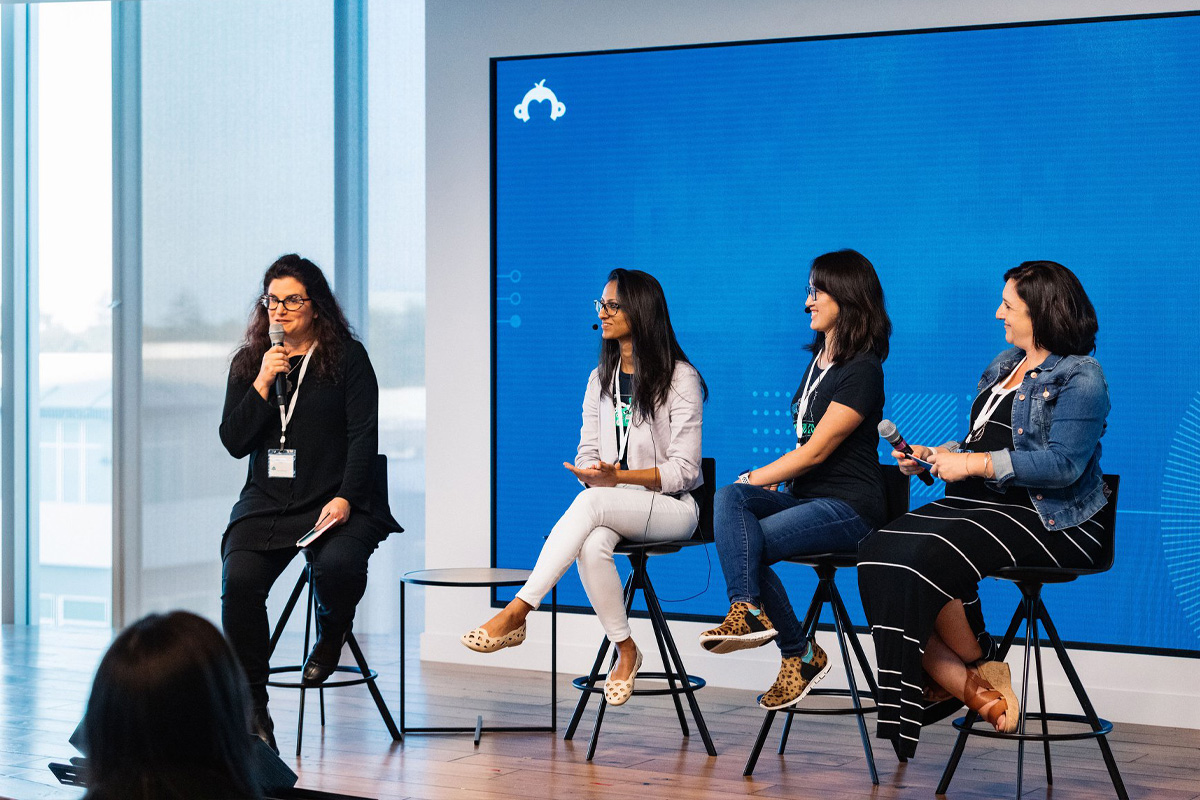
SurveyMonkey girl geeks: Robin Ducot, Shipla Apte, Jing Huang and Erica Weiss Tjader share advice and stories at SurveyMonkey Girl Geek Dinner.
Robin Ducot: I have a few questions, but let’s get started with introductions. I’m the CTO here at SurveyMonkey. I have been, let’s see, 30 years doing technology and about 15 of those years, last 15 years as an executive. I’ve managed everything from product, program, engineering, QA, ops, I don’t know, security, IT, all different types of areas from companies as big as Adobe to companies that you’ve never heard of that are gone now. I love engineering, and I’ve been here at SurveyMonkey 18 months. It’s just been a really exciting journey. Fun fact. Fun fact, I used to play in punk rock bands. People will tell you this and laugh. Also, 25. This number is the metric I use to measure the number of engineering leaders I’ve created in Silicon Valley. I love coaching and mentoring leadership skills for technologists and helping people grow into leaders of technologists is one of my passions, so 25 in Silicon Valley.
Robin Ducot: With that, why don’t we get started with some introductions of the other folks. Shilpa?
Shilpa Apte: Sure. Hello? Can you hear me?
Robin Ducot: Yeah.
Shilpa Apte: Sorry. Hi. I’m Shilpa. I’m an engineering manager here at SurveyMonkey for the respondent experience team. We’re the team that manages and innovates on the survey taking page. It’s the page you see when you take a survey. I’ve been at SurveyMonkey since I was an intern in 2012, so just about seven years. Let’s see. Highlight of my career has been getting to move to Dublin for two years to set up the engineering team there. That’s Dublin, Ireland, not Dublin, East Bay. My fun fact is that while I lived abroad, I traveled to–I did 17 weekend trips to countries I’d never been to before.
Jing Huang: Hi everyone. My name is Jing Huang. I’m a director of engineering focused on [machine learning here at SurveyMonkey. I joined SurveyMonkey for three years. Fun fact, I did a hiking trip to Everest base camp with a 14 day hike. If you’re ever hiking in a high altitude you’ll know like if you get a cold, it’s devastating. I got a cold in day five, but luckily I’m here, so I survived. I was able to complete the hike. The highest point I was able to reach was more than 18,000 feet, which is something I get to blab a lot. Some highlights of my career, I studied robotics and artificial intelligence. After graduation, I didn’t find a job in ML that was like more than a decade ago within a prime time for ML, but I was able to work on different applications from network security appliances to cloud management to big data. Finally I got an opportunity to work on ML here in SurveyMonkey, so that’s where I am.
Erica Weiss Tjader: Hello. Good evening. I’m Erica Tjader and I’m the VP of Product Design.
Erica Weiss Tjader: We had a joke in rehearsal that I wasn’t even going to need a mic I’m so loud, and they turn mine off. That’s a funny joke.
Erica Weiss Tjader: I’m Erica Tjader. I’m the VP of Product Design here at SurveyMonkey. I have been here two years. The baby is due August 1st. I thought I’d just get that out of the way so we can be done with the awkward like is she, is she not. Anyway, highlight of my career was landing this job at SurveyMonkey. I know that sounds really cliché. I promise they’re not paying me to say that. Tom, my boss, isn’t here, but I think the reason why it stands out as such a highlight to me is not just because of the great role that it is, but actually what it represents in terms of me doing some things that were really out of character for my personality. One was risk taking. When I first kind of, well I don’t know if I applied for the role, but when I first pursued the role, it was a really big step up for me in my career. I definitely did not meet all of the requirements in the job description, so it was a big risk to kind of throw my hat in for it. I think that was one big piece.
Erica Weiss Tjader: The second was intentionality. When I was starting my job search, I made a list of two, just two, criteria that I absolutely must have in my next role. I was really specific about looking for that and not settling for a role that had less. Then I think the third is patience, not my strong suit. Over the course of a couple of years, the first time I passed on SurveyMonkey, the second time they passed on me, the third time was a charm. Just the highlight of my career just I think because of how I’ve reflected on what it says about me.
Robin Ducot: Thanks, Erica. All right. Let’s start with some questions. How about we talk about your current work life. One of the things I think is really, really important is that for you to be successful, if you don’t, aren’t really engaged in what you’re doing, if you don’t really like it, it’s really, really hard to be successful because you’re just not going to be excited about putting the effort in that it really takes to make a success of yourself. What I’m curious about is what is one thing you do in your job function that gets you really, really excited to come to work? Why don’t we start with you, Shilpa.
Shilpa Apte: I love coaching and mentoring people. I love getting to know people and figuring out what their aspirations are, what skills they want to learn, where they want to take their careers and kind of seeing that progress being made over time. I see every single day as a new opportunity to learn something new about someone on my team mainly because people are complex and they change. I just think it’s an interesting problem.
Robin Ducot: Jing, what about you?
Jing Huang: I mentioned I studied robotics and I was a SciFi fan ever since I was little. I was always curious about how AI will shape our future. Getting to work on machine learning here is just dream come true. We have more than 40 billion people [inaudible] data collector here at SurveyMonkey, so this is really a dream job.
Robin Ducot: Erica?
Erica Weiss Tjader: For me, I think one of the things that I really enjoy about this role is the strength it plays to. Anybody familiar with the StandOut strengths assessment? It’s a survey template you can use in our library, but anyway, they also didn’t pay me to say that. Imagine that. I’m a connector. That’s one of the strengths that always stands out for me. I think it’s something that I get to do a lot of in my role. Whether it’s the day-to-day of connecting designers on my team with new challenges or mentors or growth opportunities, whether it’s working with teams to find ways to connect teams with other teams that have similar products or project challenges, and of course even in the nature of our product itself which is about connecting our customers with their customers for feedback. I think it’s just a role that I really get to leverage the strength a lot and that’s really energizing for me.
Robin Ducot: Thanks, Erica. Why don’t we talk a little bit about your career journey. One of the things that’s really, really important is being able to advocate for yourself. How have you guys advocated for yourselves throughout your career and what tactics have really been helpful in making you be heard? We’ll start with you, Jing.
Jing Huang: Sure. To be honest, I’m an introvert, so self advocating wasn’t natural to me. My pivotal point came when I realized self advocating is not only about self, it’s actually about advocating for your team. It’s also mutually beneficial for you and for your manager. There are two tactics I want to share today that will be helpful. I think it was helpful. Number one is to do regular updates of your work progress. Doesn’t matter if your manager asks or not, but do it. You can do it through email. You can do it through your one-on-ones. Do keep those cadence. That’s just going to be mutually beneficial because your manager wanting to know your work. That’s the number one thing.
Jing Huang: Second thing is share your knowledge with your peer, with your cross functional partners. Do tech talks. Do lunch and learn. When you go [inaudible] try to talk in conferences. This is also a mutual beneficial thing. It’s self advocating in one way, but it’s also sharing your knowledge. Everyone else is going to learn from you. Those are two things I wanted to share.
Robin Ducot: What about you, Shilpa?
Shilpa Apte: Yeah, for me self advocacy, for me it was a pivot when I realized that if you do it a little bit over time, it’s much easier to have important conversations when you really need to rather than trying to do a big one all at once. The way in which I do that is, one, to just believe in myself. I think if you believe in yourself, build confidence in your abilities, it trickles into everything you do. Two, understanding what your manager expects of you and meeting those expectations, it’s just easy points. That’s not to say that you should feel restricted by those expectations, but I think that’s kind of a baseline. Beyond that, you should kind of like, what Jing said, be giving regular updates about what you’re working on. The third is really being able to articulate what value your work is creating for the business and for your team and making sure that your manager understands that as well.
Robin Ducot: Those are great suggestions. It’s funny, for me, one of the things I’ve noticed is that developing a very strong sense of entitlement, which sounds negative, but I swear it’s positive, developing a sense of entitlement that you are allowed to be in the room, especially for female technologists I’ve noticed this is an issue. I was fortunate in that I’m third generation technology leader in my family, so I didn’t realize women weren’t supposed to have a voice around technology. I’ve noticed that it’s really, really important that you feel entitled to speak up. Your voice is just as important as anybody else’s. If somebody interrupts you, interrupt them back. You know?
Erica Weiss Tjader: Well said. Well said.
Robin Ducot: All right. Moving on. Mentorship. People talk a lot about mentorship, but what’s interesting is some of the most influential relationships that you end up having because they’re more common are the allies that you develop in the workplace. I’m a little bit curious about, for you, Erica, tell me a little bit about some of the experiences you’ve had with allies.
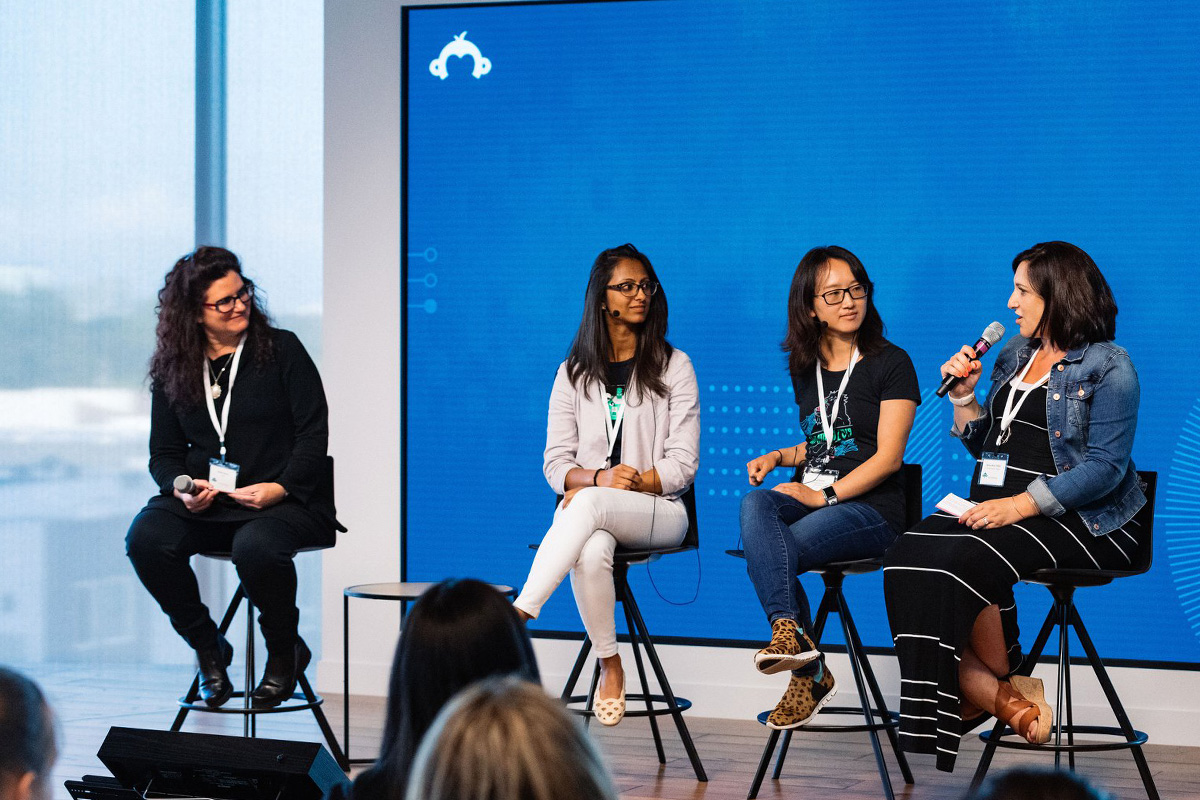
VP of Product Design Erica Weiss Tjader shares tips for making allies in the workplace, for your professional success, at SurveyMonkey Girl Geek Dinner.
Erica Weiss Tjader: It’s an honor to have Robin Ducot ask me this question because she is one of my greatest allies here at SurveyMonkey, but that’s not what I’m going to talk about. I was actually trying to think of a really good example, and I found the list was so long I couldn’t even remember the last names of half of the people that were coming to mind, which I think is either indicative of my memory or actually the nature of allies. Unlike mentors, allies are not big investments in relationships over time. They are episodic. They are based on a specific purpose at a specific place and time. As a result, they can have a really much bigger impact on something you’re trying to achieve at the time.
Erica Weiss Tjader: A good example that I thought of is in a previous role I was a design leader of a smaller team. One of my biggest challenges that I was facing was making inroads with our engineering leadership around the notion of, the importance of front end development, design systems, some of the topics that design and leaders and engineering leaders often talk about. I was having a hard time getting traction. It was one of those tough problems because it was probably the most important thing to my team and yet the thing I had the least direct control over. This was an example. I have to influence because I don’t own the answer to the problem. This particular ally was a new engineering manager that joined the organization. In my initial just meet and greet with him, I learned that he had some expertise around developing front end teams and design systems and sort of an interest. Perhaps most importantly, I learned that he had a personal relationship with our CTO who was the person I was having the hardest time making inroads with.
Robin Ducot: Wasn’t me.
Erica Weiss Tjader: They were personal friends. No, it was a different story. I’ve got a lot of stories.
Erica Weiss Tjader: What I did is I really just started out by befriending this guy. I’m like I’m going to make your transition into this company really easy. I’m going to introduce you to people. I’m going to tell you all the secrets. We had lunches. We had coffees. We started to build a relationship, and in a very short period of time we were able to transition that relationship into finding a mutually beneficial place where he was able to leverage his expertise and his influence in the engineering organization to start a front end team and I was able to give him disproportionately more resources and support from the design team to really improve the value and success of that.
Erica Weiss Tjader: I think it’s just a great example of an alliance that was very intentional, but looked very different than a mentorship relationship because it was really about a place and a time and a need and a relationship right in that moment.
Robin Ducot: That’s a wonderful story. I mean I think that’s something that’s really, really important. I know as an engineering leader, one of the allies that I always develop when I first join a company is the person who runs the customer support team, making sure that they understand that I am there to help them when we screw up because obviously the site does have issues on occasion. Making sure that you have that relationship so that they support you when you inevitably screw up and then you can support them. I’ve noticed over the years that this is a pattern that really, really works.
Robin Ducot: I do have a question. We are in sort of the center of the feedback economy, SurveyMonkey is. I feel like feedback is–one of the reasons I love working here is because I love data, I love feedback, I love learning new things and driving insights from data. One of the things, though, that I’m curious about is feedback is so important in developing our career. What is some feedback that you’ve gotten? We’ll start with you, Shilpa, that you’ve gotten that really made a material impact on you?
Shilpa Apte: It really can be summed up in two words. Be reliable. That’s not to say I was unreliable, but you commit to something and it starts slipping and you don’t tell the person that you told you would do it in time that it’s slipping. I don’t know. These little habits that build over time I think I kind of realized that you can be the smartest person and the most talented person in the room, but if people can’t rely on you long term, they’re not going to want you to be on their team. I think once I realized that, that kind of just staying on top of things and making sure, even if I’m not going to complete something that I said I was going to, just communicating that out made my relationships and trust between colleagues a lot stronger. That was kind of a career shift for me.
Robin Ducot: That’s great. For me probably, if I think of some of the best feedback I’ve ever gotten, I have a lot of imagination and I like organization structures and redefining things. As a leader, I got the feedback from an executive coach some time ago that, you’ve got to stop reorging every week. You’ve got to stop all that shenanigans with the reorgs because people, you may be able to surf over the top of all this change and this chaos and you like change, but people, a lot of people like stability. Stop. It was really, really helpful to me because it helped me see the world slightly differently than the way I’d been seeing it. I was like but it’s so exciting all this change. They were like actually you’re killing people. I think that getting feedback, soliciting feedback and listening to it is a really, really important part of developing your career.
Robin Ducot: Advice for others. What skills and experience have been the most valuable to you in developing your career growth? What advice would you give to somebody if they wanted to turn to a career in tech? Jing, we’ll ask you this question.
Jing Huang: Sure. When I think of this question, I actually think of it from a different angle because tech, or the industry we’re in, is fast growing, ever changing. It is not any particular skill or experience that will determine our successful in this industry. It is what I believe is the growth mindset that we all should have and the willingness to learn new things and the courage to actually take on new challenge. I think if you have that, you will be able to learn. Just be sure that you’re actually enjoying doing tech in the first place, right? If you’re sure with that and learn, you will be successful. It’s just time.
Jing Huang: One thing I liked about what Steve Jobs said, long pause, this is an old sentence, but I think it always inspired me is really you cannot look on how dots connected when you look forward. You only see the connections backwards. When you see a new challenge, when you see a new opportunity, take it. Do it. You will find how that’s connected after some years. Robin would know better.
Robin Ducot: Because I’m old, yeah. Lots of connections.
Robin Ducot: I think one thing that’s really important, if you’re thinking about a job in tech is that you have to like solving problems. As an engineer, that is your job. Your job is to come up with interesting and creative ways to solve problems. If you don’t like solving problems, if you think problems are a pain, then you’re not going to really enjoy being an engineer. To Jing’s point about start first to see whether basically this looks like an interesting career to you because if you don’t enjoy it, if you don’t enjoy solving problems, you’re not going to enjoy being an engineer.
Robin Ducot: With that, our final question we’ll take to Erica about finding the right company, the right place to work. What advice would you give the women in the audience who are looking to change companies?
Erica Weiss Tjader: First, I’d say the recruiting booth is over there. No, in all seriousness, I think the first question I’d ask is why are you looking to change companies? Are you running away from something or to something? I think it’s really important to be true to ourselves and be really specific with ourselves when we start to think about making an important change like that and start with the foundational assumption that there’s no perfect job, there’s no perfect company, there’s only the right job and the right company for you right now. I think how do you get to that assessment? I always encourage people to start with a list of what are the top three most important criteria for your next role. You only get three. There’s somebody in the audience I know I’ve interviewed recently, so she’s familiar with the question. Don’t worry. She’s joining.
Erica Weiss Tjader: Anyway, I digress. Start with your three criteria and then be really intentional about how you go out and look for a role that meets that criteria. As women in technology in the Bay Area, we all have the luxury of recruiters hitting us up all the time, of going to events like this where hiring is a big focus. Talk to those people who are seeking you out, but also seek out companies and people who you think are interesting or who you think might meet your criteria well. Have coffees. Have lunches and casual conversations. Find that role that really speaks to what you’re looking for. I often say that the best reason to look for a new job, not the only reason, but probably the best reason is because you’re looking for a very specific type of growth or opportunity that your current company can’t give you at this time. Usually it’s no fault of the company. It has to do with the size or the stage or the priority.
Erica Weiss Tjader: Have those specific criteria, be deliberate, and then go out and look for a job and do not accept a job that meets any less than two of your three criteria. I think just be really true to yourself there. I think the last thing I would say in terms of advice here is to really be open minded and flexible because after you’ve gone through that process of thinking through your criteria, of talking to people, you actually might find that you look at your current company through a different lens or see opportunities there in a different way. It might be that right now that company is the place that meets your criteria the best. Really just be open minded in that search and clear about what you’re looking for and what you’re running away from or running towards.
Robin Ducot: That’s really, really great advice. Another thing I would also think about is that you are joining a group of people and if you don’t like them or if you don’t like the person you’re going to work for, doesn’t matter how great the company is, your job is going to suck. They really are not going to be good advocate for you. If you don’t connect with them, if you don’t feel like they are somebody who is going to really understand your deal and what’s good and strong about you in particular, they don’t appreciate it, then find somebody else to work for. That’s my small piece of advice on finding companies to work for.
Robin Ducot: That is our last formal question. What we’d love to do is get questions from the audience. We are, I’m just wondering, do we have a mic we can hand around? All right.
Erica Weiss Tjader: Bernice is over there with a mic.
Robin Ducot: We have a question here.
Natalia: Hi. I’m Natalia.
Robin Ducot: Hi, Natalia.
Natalia: Should I stand up so everybody can see? I’m really curious about how you approach difficulty to make people feel in the survey. We’ve already heard about best practices, how to run great survey, but how to encourage people to look into it? Maybe let me also explain the question where it’s coming from. Five years ago whenever I received a survey, I just filled it in because it was new and it was so cool. Now I receive surveys like in my career and then private ones and then some place for my husband and so on and so forth. There’s a lot of them. How do you make people start the survey?
Robin Ducot: I think I’m going to have Sarah, if she’s okay with that, come up here and maybe answer that question just as our survey research expert.
Erica Weiss Tjader: Sarah, I’ve got a mic for you. You thought you were getting away.
Sarah Cho: It’s a little hard to hear over there. Do you mind repeating what you had to say?
Natalia: Can you hear me?
Sarah Cho: Oh, how to increase response rates. Was that the question?
Natalia: Yeah, so how do you make people actually start the survey because [inaudible] so many of them from various sources.
Sarah Cho: That’s a really good question. A lot of people worry about response rates, so there’s a couple of things that you can think about. Number one, how are you inviting them? How many of you guys, every workplace has this, has this type of person. We utilize Slack here, so I’m sure you guys might utilize this. I hate it when someone Slacks me and says, “Hey.”
Sarah Cho: Then you’re forced to say, “Hey, how can I help you?” I find that, that’s like one of my pet peeves. It’s the same thing with survey invitations. If you just say, “Hey, take my survey” what’s the incentive for anyone to actually take your survey? That’s not engaging. That’s not personalized. That’s nothing, right? One of the things is to really think clearly about your invitation. It’s best if you can customize it. If you know the person’s name, utilize the person’s name. If you can disclose what the survey is about, give a quick one sentence, not too long again, description of what the survey is about. The other thing to remember is the first impression is the biggest impression that you can make. Again, thinking about the invitation, you don’t want to use too much text because people are going to get overwhelmed and not read it. Same thing goes for the first question in your survey.
Sarah Cho: If you start with a really hard question, we actually see this because we collect so many responses. We can actually go through our database and see what decreases response rates and what increases it. The first question is actually one of the most crucial. If you start with an open-ended question, which is really hard for people because you have to type out your answer, your completion rate automatically drops on average around 15 percentage points. That’s a lot. If you just start with an easy question, even if it’s like a soft opener that you kind of need to throw away, that’s always best. Start with a multiple choice easy question.
Sarah Cho: Those are two small things that you can do. Number one, personalize how you’re inviting people in, and number two, make your first question easy. There’s a lot of other things that you can consider, like incentives, but that’s a whole ‘nother talk. I’ll save that for later.
Shilpa Apte: I would also just add on that within the product itself when you’re creating a survey, there’s a tool called Survey Genius that actually tells you, you’re welcome, that tells you, kind of scores your survey and gives you feedback on how you can improve response rates based on question ordering and length and all that.
Robin Ducot: Who’s got the mic? Bernice.
Audience Member: Can you hear me? My question is if we’re not necessarily sure our three, oh sorry. I won’t yell. All right. If we’re not necessarily sure what our three criteria are, what we want to do, what we want our next step to be, how can we go about finding that next step and just kind of a general what do you want to be when you grow up more?
Erica Weiss Tjader: A couple of us might have thoughts here. My first thought is don’t try to make one of your criteria like this is what I want to be 20 years from now when I grow up. That’s like this well thought through career that probably won’t even exist 20 years from now, right? I think when I talk about criteria, I’m actually talking about really specific attributes of your role. For example, one of my criteria when I was joining SurveyMonkey was I had a 10 month old at home. I knew that eventually I was going to want to have another child. I knew that I was going to work a lot of hours no matter where I went, so I knew short commute was super important to me. One of my two was short commute.
Erica Weiss Tjader: I think it’s about what is important to you in your life right now. If you’re earlier in your career, you might say what I really like is I’m a really outgoing person and I really get a lot of energy from talking to people. If I don’t know what function I want to be in, I know that it’s super important to me to have a role where I interact with people for more than half of my day. Then you can start having the conversations and you’ll find out which roles actually fit that criteria and which don’t, but don’t start out with like I must be in sales or I must be a front end engineer, like trying to get too specific about the career path. I think that will emerge for you as you think about what kind of work or environment gives you energy and you’re passionate about.
Jing Huang: One thing I think I can add on is when you really don’t know what you really like, I think when I was in school this was a question. Look at what other opportunities are out there. Try to do them. You can always think about you like or not, but that’s just thinking. You have to do it and actually test if you actually like it or not. Don’t pass an opportunity thinking you may not like it. If there’s an opportunity, actually catch it and try to do something about it.
Robin Ducot: Experiment.
Audience Member My question is how do you solicit constructive feedback? I find, personally I find asking directly is not the most effective way. Actually, I’ve been thinking about sending out survey. I’m wondering if you have any insights.
Robin Ducot: We’re running a feedback survey right now in engineering. Anonymous is good. If you really want to find out, for an organization or for something that you’re doing, anonymous is good. If it’s personal, if you’re trying to get feedback from people personally, you just have to show that–it takes time to get people to trust you, that you won’t freak out. Ask for feedback and it’s still too sugar coated, poke a little. Have it be a little less sugar coated. Poke a little, less sugar coated. Not reacting. Just keep asking questions. Then people will start being willing to give you the kind of feedback that you really need because you need people to believe that you can handle it, right? That’s why people sugar coat things because they don’t want to deal with people’s emotions when they upset them.
Robin Ducot: Present yourself as somebody who is just interested in the facts and it really, really helps.
Erica Weiss Tjader: I think another trick I’ve called on for some of the folks on my team, I’ve had people reporting to me who are the type of people who always get positive feedback. Every time we send the anonymous peer feedback 360 survey, everybody says they love working with me. By the way, that’s true. That means that you’re great and you should feel really good about that, but obviously it’s not as constructive. I think there’s a couple tricks. One is ask a different level of person for feedback. Perhaps you’re asking people who are your current peers, not the people who you would like to be your peers in your next role, right, in terms of thinking about asking the next level.
Erica Weiss Tjader: The other thing is asking the question in a different way. Rather than saying, let’s just say your ambition is to be a more influential leader. Rather than asking somebody what room for improvement do I have or some sort of generic question, ask I’m really focused on trying to have more influence as a leader. What are some areas where you think I could be more influential? What could I do differently to have more influence? Really ask about the thing that you have identified as the thing you want feedback on specifically as opposed to just general feedback questions.
Robin Ducot: Yeah. I’ve noticed also real time feedback. You’re in a meeting and the meeting’s over. Asking the person do you think that thing I said in the meeting was okay, where you’re right there in the moment and they might be more inclined to give you feedback because you just had this experience. It’s hard also for people to remember if you’re asking things that are too general. It might be another thing that could help you.
Robin Ducot: We’ve got a question back there in the orange.
Audience Member Can you hear me?
Robin Ducot: Yes.
Audience Member Thank you again for organizing this. I have used SurveyMonkey for many years for my own events. I used to be in marketing, so thanks for this opportunity to see you in person. I used to be an engineer who moved into marketing, product management, sales ops, kind of seen all the 360 of the business. One of the comments Robin made around problem solving, that one aspect that I learned in engineering has stayed with me throughout my career, so I just wanted to say that to the audience and also to anybody who is in tech, if you don’t like problem solving, then your career, you basically are lost.
Audience Member: The one question I have is in engineering especially, given that I’ve done everything, I’m realizing now that if I wanted to come back, what sort of strategic leadership roles could one aspire to? Is that even possible?
Robin Ducot: You mean you want to move laterally from where you are, the level that you’re at now, back into engineering?
Audience Member: Yes.
Robin Ducot: Probably you’d have to go join engineering at the level you left, not the level that you are, just because engineering leadership, usually you need to have the respect of the engineers that are working for you, and that means having been sort of through the ranks of leadership and engineering. At least that’s been my observation. If you’re willing to go back and if you left as an engineering manager, joining as an engineering manager again and working your way up, at least that’s what I would guess unless you go to a start up. A start up, everything’s possible. You can be a CTO at a start up with an accounting degree. It’s totally fine. Just write some code.
Robin Ducot: Sometimes I’ll tell people that. You get somebody who is like I want to be a CTO now. I’m like go join a start up. You can do that. Knock yourself out. Anyway, I digress. I think if you really want the leadership role early, start ups are great for that.
Audience Member: Hi. I have a question. What if you like what you’re doing, but you just don’t like the people you’re working with?
Robin Ducot: Get a new job. Get a new job.
Robin Ducot: We got recruiting over there.
Robin Ducot: Life is too short. If you hate the people you work with, get a new job. You’re not going to be able to fix them. I’m just saying. I don’t know if somebody has a more sophisticated answer than that.
Audience Member: Hi there. My name’s Vidia. It’s fantastic to be here and see all these women at the panel here. It’s been great. Robin, my question is for you. It’s great to see a female CTO. My world is full of the other gender, so it’s very nice seeing this. Can you talk about your journey? You said you’ve been in tech for 30 years? What were your pivotal moments when you look back now and said okay this was a game changer? I’m sure you have a few.
Robin Ducot: Oh boy. I was really lucky. Like I said, my mother ran a huge research team at MIT, so I didn’t know. I didn’t know. I didn’t know women weren’t supposed to be engineers. Nobody told me that. I also liked being an outsider. I was a punk rocker. I didn’t mind being the only female engineer in the room, and again didn’t realize I wasn’t supposed to be there because nobody told me and I didn’t mind being an outsider. I was really, really lucky. I think that along the way things that I had to learn that were hard to me, when I realized that after getting into fights with more than one boss over multiple companies realizing that it was me, that it wasn’t them, that it was me, and that I had to work for people that I liked and who understood my special snowflake self.
Robin Ducot: I think that everybody’s got a certain set of strengths and weaknesses. Over the years, developing a career around my strengths and then hiring from my weakness. It’s not one specific story. It’s sort of a constellation of experiences that have led me to believe that if you focus on your strengths and hire for your weaknesses, you could actually be really, really successful. I don’t know. It’s kind of a long, windy answer to that because I don’t really have specific things that come to mind as oh my God that time when. There have been moments in time of pieces of advice I’ve gotten. Because I will have a street fight about things, I got the advice once of, Robin, sometimes you just got to keep your head down. Keep your head down and just keep moving. All those people that you want to kill, they’ll be gone and you’ll still be there. Then you get to run the show.
Robin Ducot: The guy who gave me that advice is my boss here. I worked with him 20 years, I mean we’ve been working together on and off 20 years. That was a long time ago. It was great advice. Anyway, there’s been lots and lots of little experiences that have brought me where I am, but I do think focusing on your strengths and being resilient. You’re going to get your ass kicked every day. Just keep showing up. That’s been my experience. Again, like I said, I liked being an outsider so I didn’t really mind. I always thought this is my fight to have, but what I’m realizing and what I’ve come to realize as trying to help other women move through, not everybody likes being an outsider. Not everybody wants to have that fight and they shouldn’t have to. You shouldn’t have to have that fight. It shouldn’t be part of the deal. You should just be able to be a woman in tech and not have it be a big deal.
Robin Ducot: It kind of annoys me actually sometimes. I feel like I’m a prized poodle that’s being trotted out. Female technology leader. I want that to be the norm. I want that to be everyone can be a CTO and be female. It’s like that’s not a thing, but we’re not there yet. I recognize that. That’s just my long winded answer to your question.
Audience Member: Hi. My question is SurveyMonkey consider yourself like Uber in survey industry? If not or yes, what is your major competition?
Shilpa Apte: Do we consider ourselves to be Uber in surveys and who is our major competition?
Robin Ducot: We are the Uber of surveys. Oh yes. Oh yes.
Robin Ducot: It depends on what market, actually who our biggest competitors are. It depends on whether it’s the consumer market, sort of low end surveys, basic surveys, and then you have Google forms and things like, I don’t know, Type Form. That’s who I was thinking of. Type Form. See how much I worry about them? Then at the high end in market research you have Qualtrics. One of the things I love about SurveyMonkey is that our product works for all of these markets, for the big and the small, and that’s actually what makes us unusual. Type Form doesn’t work for market research and Qualtrics doesn’t work for the basic user.
Robin Ducot: Yes, we are amazing. I totally think that.
Angelica: I had a question. I actually had the reverse question of someone here who asked a question. My name is Angelica and I’ve been in the tech industry for about ten years now. I’ve been fortunate to have a very supportive boss and team. My situation is I don’t really like what I’m doing anymore. It’s a short glass ceiling where I’m at and there’s not really a lot of room for growth or advancement. Just asking for anyone’s opinions about being in that kind of situation, having a supportive team and a supportive boss, but not really being happy with what you’re doing.
Erica Weiss Tjader: I think we call that the curse of being too comfortable or something like that. Again, I started with the there is no perfect job, there is no perfect company. I think it depends where you are in your life. I think you might be at a point in your life where you’re like these are the years where I want to work hard and I want to charge ahead and I’m willing to pay the price to do that. Therefore, staying in a role where you know that there’s no growth for you is probably not a good idea. You may be at a stage in your life where you’re like you know what I need? I need to feel supported. I need to feel happy going to work every day because the people I’m working with. At this stage right now maybe actually climbing that ladder is not my top priority.
Erica Weiss Tjader: I think it really depends where you are, but I think if you are at a place where growth is important in terms of your–personally and you recognize that is not what you have at this company, I guess the first question is are there other roles within the company where you could find growth and other avenues to explore there? If not, that’s probably the right time to start looking at what else is out there.
Robin Ducot: Absolutely.
Audience Member: Hi. Thank you very much for sharing your advice today. I came from a finance marketing background and being in the Bay area, obviously tech is where it is. Want to know what’s your perspective on boot campers as well as if you have any advice for reframing other industry experience for transitioning to tech. Thank you.
Robin Ducot: I have some thoughts about this, but I don’t know if you guys want to share. I think that boot camps are typically really, really great feeders for small startups and tend to be less effective for getting jobs at larger companies who have big internship programs, but startups usually don’t. They are very excited about taking boot camp folks. I’ve worked at all different size companies and that’s been the pattern is that typically small companies eventually grow out of the boot camp feeder just because there is a lot more risk. As companies get bigger, they’ll take the CS degrees from their intern programs as the sort of feeder into the low level engineers.
Robin Ducot: I love startups. I think the experience you get at startups is amazing. I think that going through a boot camp and ending up at a startup is an amazing way to start your technology journey.
Jing Huang: One thing I think of, like your background in finance, right? Cross functional. If you think about tech today, having a knowledge of a different industry is actually very valuable. Taking tech applied for finance. Think about, for example, data science. There’s a big application on data science for finance. Those are areas where you actually have a unique strength to segue into tech if that’s what you want to do.
Audience Member: Everybody heard about the bro culture here in Silicon Valley. Is there a thing in SurveyMonkey or any other job you had before and how did you deal with it? How did you handle situations like mansplaining or competing for role, climbing the ladder?
Robin Ducot: Mansplaining? Sarcasm. Really? Really?
Audience Member: What about the career ladder?
Robin Ducot: For career ladder, I mean SurveyMonkey does not have a bro culture. It’s actually one of the wonderful things about SurveyMonkey. Do you guys agree with that? Yeah. I think that’s one of the things that actually was a little bit interesting of a transition for me when I joined was that I didn’t have to have that kind of, didn’t have to whip out the sarcasm quite as frequently. I think from the career ladder, I think it’s really just important to advocate for yourself. Men ask. I always asked. Always. Every single promotion I’ve ever gotten, I asked for. Every single one. It’s not because they didn’t think I was good. It’s just that people pay attention to people who are asking. That would be the thing that I would say is that the bro culture thing, I don’t know what to do about that.
Robin Ducot: I just tell them to knock it off and move on. I don’t know if you guys–
Shilpa Apte: Getting more women into tech.
Robin Ducot: I think that’s actually the best way to solve for it is if you’re a leader is to bring more women in. Then it gets diluted and, I don’t know, slows down. As an individual that doesn’t have the power to change it, if the company is really obnoxious and doesn’t fit your cultural values, then maybe look for some other place. Also, just tell people to knock it off. That’s my favorite thing to do. Whether you feel comfortable doing that is really sort of your thing. As for career growth, you really have to just keep, I mean one of the things that Jing mentioned, which is so important, is making people aware of what you’re doing. Just making sure that your competency is visible and whether it’s tech talks, speaking, things like that so that people become aware of your value to the organization.
Robin Ducot: I don’t know if that’s helpful. I don’t know what to say about the actual bro culture, I mean to fix it. It’s mostly just bringing more women in and not tolerating it when people are obnoxious.
Olga: Hello everyone. My name’s Olga. My question is about technical excellence. Whenever you come as a technical lead or an architect to the company, to the new company, you always have to prove yourself. Unfortunately, I am doing my engineering for 15 years. I built system that always run whenever I leave the companies, but still, like five years ago when I joined Salesforce, I had to prove myself by designing this complex system and building it myself. Then people realized what I really worth and was very surprised that I did this. Unfortunately, I do the same at Google right now. I still have to prove myself and building this complex system and designing this myself because I find that people, maybe they trust me, but they don’t trust as much as I would like. I see they trust some other people. They’re just not the same kind of expertise and the same bar that they expect from the technical lead.
Olga: I was wondering, is it going to happen at all the companies, just like when I join any new this is what happens? You try to stay at the same company for longer or there’s some other skills you can do so you can prove without building this complex system, like writing the code yourself?
Robin Ducot: I think storytelling is a gift that it takes, it’s useful to develop. I’m not sure if you guys agree with this, but I think that one of the challenges, and I don’t think this is a male/female thing actually. I think this is maybe an introvert/extrovert thing. You’ll get people who are just really good at telling their story and selling themselves. These are skills you can develop. Storytelling, selling skills, being able to tell the story of the things you’ve done in the past and being confident about it, feeling a sense of being entitled to be in the room and telling your story is really, really an important skill that will shortcut some of that. I think in engineering, though, engineering tends to be a show me kind of culture. It’s this intersection of being able to talk about technology and learning how to tell the story of all the things you’ve done in the past so that people will listen and telling it in a way that they will listen, not the way that you want to tell the story, but the way they will hear it.
Robin Ducot: You can definitely get coaching in that specific area if it’s something that you’re finding frustrating. I mean some of it is just when you start a new company you do have to tend to prove yourself a little bit. That’s just sort of part of it. I don’t know if you guys have some thoughts about that.
Jing Huang: Totally agree. I was an engineer developer myself. Like I said, self advocating was not natural. Same thing for you. It just feels like we need to do the work to prove ourselves, but in a lot of cases, we have peers or male peers that came to them more naturally where they’d just be able to tell the story about the work they have done instead of having to build something again and again doing the same job to prove what we already been able to do. Learn the skill to really be able to sell your story, self advocating. If that doesn’t come naturally, like Robin mentioned, get some coaching. Really just improve that set. Be confident.
Robin Ducot: Strategically placed solving other people’s problems also becomes a story that people will tell about you. One of the ways when I was still writing a lot of code, I would come in and help somebody solve a problem that they were having. You do that enough and people will trust you without you having to be designing something from scratch and building a whole up system, but being able to troubleshoot their systems because if you’re good at writing a system, if you can really build such a system from scratch, then you might be able to help somebody else fix theirs. Helping people fix their problems makes you very, very popular. Very popular.
Robin Ducot: What’s going on back there?
Audience Member: First of all, thank you for sharing your experiences as inspiring technology leaders. Looking back at your career journey, what was the best decision you made and the worst decision you made and why?
Jing Huang: It’s such a hard question.
Robin Ducot: Don’t try to get your boss fired. Don’t try to get your boss fired. It does not work. Even if they suck and they deserve to be fired, don’t try to get them fired because…. Complex, yeah. How about that?
Robin Ducot: Jing, you got something more?
Jing Huang: I couldn’t think of any like really worse decision you could make. I think every decision, there is different perspective. There is different outcome, but there is always a way out. I think that’s an opportunity. Nothing really bad could happen. Either you stay with a job or you leave for another company. It’s a choice. It’s an opportunity that you will make because of your decision. There’s nothing really bad that’s going to happen.
Robin Ducot: Yeah. It’s actually interesting. The most important thing is how you get back up if you, so take risks. You’re going to fail. It’s okay. You learn. I mean in my experience you learn from failure, not from success. Take everything as a learning experience and get back up and do it again. I don’t know. I’ve had so many learning experiences that have helped me learn.
Robin Ducot: Okay, we are at 8:30. Holy mackerel.
Robin Ducot: One more question right here I guess, and then we’ll-
Audience Member: I’m actually looking for advice. Imagine a manager kind of experienced outsider looking for a new position. This manager, let’s say me, I find a position in a company that I really admire. I look through the qualifications and I look through this job responsibilities and I know that I’m going to excel at this job, but all of this preferred qualification may not match what you actually have on resume. How do you grab this attention? How do you break through? How do you be noticed by either a recruiter or a hiring manager when you apply to this job?
Robin Ducot: I mean the question is, so you have the qualifications, but your resume doesn’t illustrate that you have the qualifications?
Audience Member: [inaudible] some specifics. For example–
Robin Ducot: Yeah, what’s an example of a specific? A specific programming language or something?
Audience Member: Yeah. It’s like a particular experience or, let’s say, experience in network or experience of working with healthcare for example.
Robin Ducot: You know, it’s funny, men will just apply. You just apply. This is one of the things we talk about. Actually when we create job descriptions, we’re really careful to make them so that they’re inclusive, that women are not going to automatically exclude themselves because there’s too much specificity in them. If you reduce the amount of specificity, then you’re going to get a wider range of people because the reality is that you don’t really know what you want exactly. You write a job description and then people show up and you’re like, hey, I kind of like you. You really don’t match the job description exactly, but you have something that’s special that will really resonate with the team. Apply anyway.
Audience Member: [inaudible].
Robin Ducot: Sorry, I can’t hear you.
Erica Weiss Tjader: I think, how to stand out. One thing, I’ll take on that, the reality of, depending where you’re applying, most companies the resumes that are coming through the application system are being reviewed by the recruiters and the recruiters, while great partners to the hiring managers, they know what they’re supposed to look for based on the resume. If it doesn’t match, you’re most likely to get passed on. Doesn’t mean you shouldn’t apply and you shouldn’t go through the recruiter. I think it’s a yes and figure out how to get in to a company, how to talk to real people, how to network. Again, I think it’s a lot harder. Let’s say you were interested in a design manager role on my team, which hopefully you’re not because then this will become awkward, but let’s just say you reach out to me and you’re like I really want to be considered for the role. Can we talk?
Erica Weiss Tjader: I might look at your resume and go I’m not sure, but if you reach out to me and say your experience looks really interesting, I’d love to pick your brain. Can I buy you a coffee? I might be like, oh yeah, okay, maybe, yeah. Then while we’re having coffee, you might somehow slip in the fact that actually I’m looking for a job. Would you ever consider somebody like me? Again, hopefully I didn’t just play out some future scenario that we’re going to have because that would be really weird, but I think it’s like if you come at it from I’m a job seeker, I’m a job seeker, I’m a job seeker, you might find that’s not the best way to build a relationship. Talking to people in the organization and finding your way through is how you’re going to stand out either because your resume looks exactly the same as everybody else’s or not quite the same as everybody else’s.
Robin Ducot: See if you can find out who the hiring manager is and then use LinkedIn to see if you’re connected to them. I mean that’s probably the most straightforward way to sort of do an around the process. Yeah. LinkedIn is your friend.
Robin Ducot: We are being kicked off the stage. Thank you so much and please enjoy the rest of the evening.
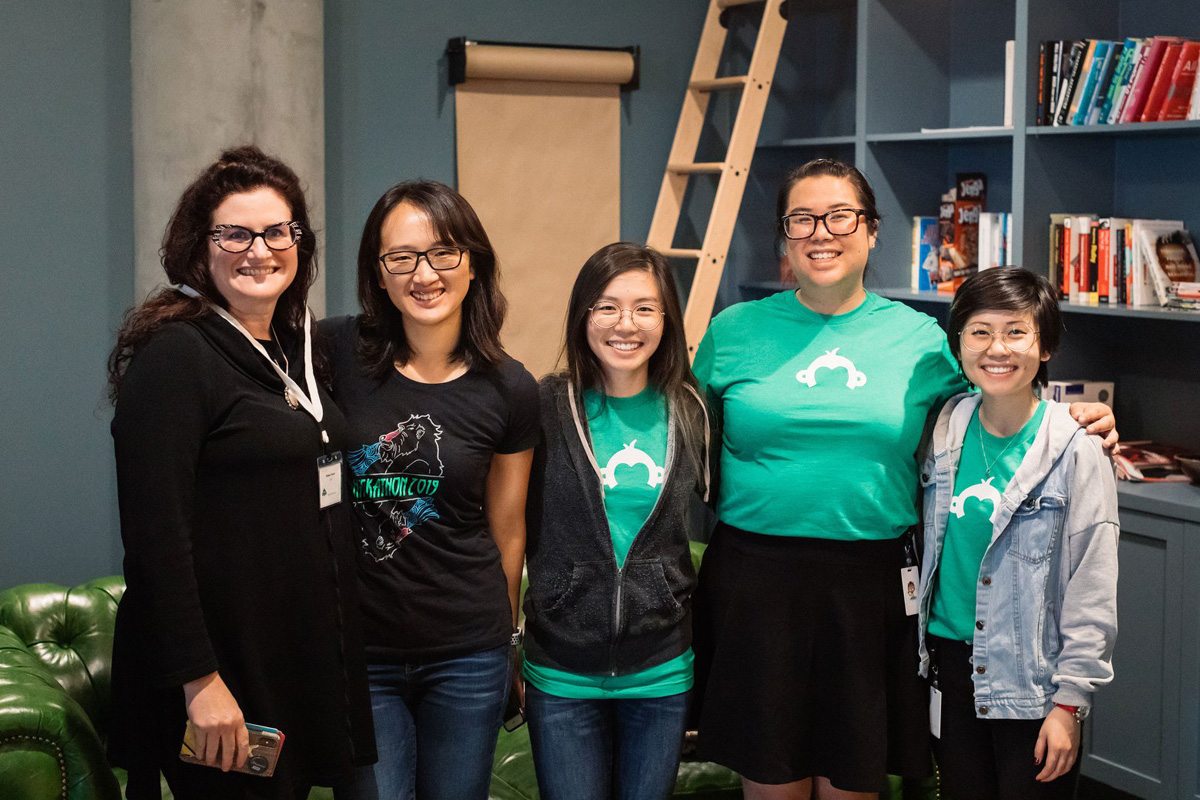
Thanks to all the SurveyMonkey girl geeks who helped make the SurveyMonkey Girl Geek Dinner possible! We had a fantastic time.
Our mission-aligned Girl Geek X partners are hiring!


